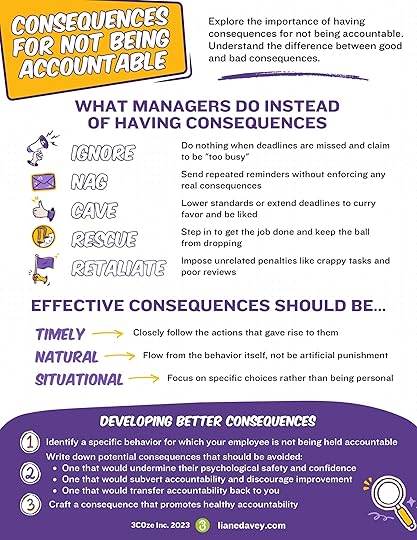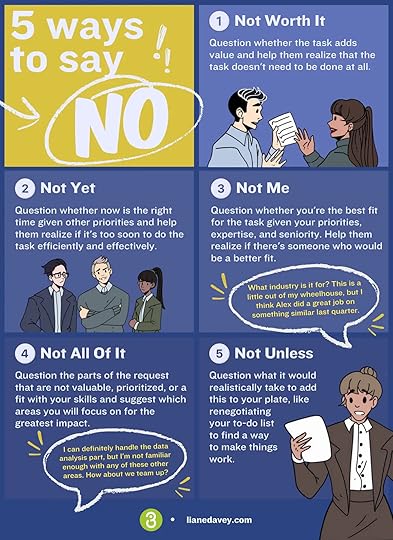Liane Davey's Blog, page 4
January 12, 2025
Consequences For Not Being Accountable Poster
If you’re unwilling to impose consequences, you’re not serious about accountability. When I ask for examples of how they respond to poor performance, few people can describe any consequences for not being accountable.
Make Your Consquences Count Go Deeper By Crafting Better Feedback More on Accountability #pcp_wrapper-15278:not(.sps-glossary-layout) .sp-pcp-row,#pcp_wrapper-15278 .sps-glossary-items-group .sps-glossary-items-content {margin-right: -11px;margin-left: -11px;}#pcp_wrapper-15278 .sp-pcp-row [class*='sp-pcp-col-'],#pcp_wrapper-15278 .sp-pcp-row .sp-pcp-block-hierarchical{padding-right: 11px;padding-left: 11px; padding-bottom:22px;}.pcp-wrapper-15278 .sp-pcp-title a,.pcp-modal-15278 .sp-pcp-title, .pcp-wrapper-15278 .pcp-collapse-header a{font-family: Poppins;font-weight: 500;font-style: normal;text-align: left;text-transform: none;font-size: 20px;line-height: 24px;letter-spacing: 0px;color: #111;display: inherit;}.pcp-wrapper-15278 .sp-pcp-title, .pcp-modal-15278 .sp-pcp-title {margin: 0px 0px 6px 0px;}.pcp-wrapper-15278 .pcp-collapse-header a{display: inline-block;}.pcp-modal-15278 .sp-pcp-title{text-align: left;color: #111; display: block;}.pcp-wrapper-15278 .sp-pcp-title a:hover,.pcp-wrapper-15278 .pcp-collapse-header:hover a{color: #e1624b;}#pcp_wrapper-15278 .pcp-carousel-fade:not(.swiper-rtl) .swiper-slide .sp-smart-pro-item:not(:last-child), #pcp_wrapper-15278 .swiper-cube:not(.swiper-rtl) .swiper-slide [class~='sp-smart-pro-item'], #pcp_wrapper-15278 .swiper-flip:not(.swiper-rtl) .swiper-slide [class~='sp-smart-pro-item']{margin-right:22px;}#pcp_wrapper-15278 .pcp-carousel-fade.swiper-rtl .swiper-slide .sp-smart-pro-item:not(:last-child), #pcp_wrapper-15278 .swipe-cube.swiper-rtl .swiper-slide [class~='sp-smart-pro-item'], #pcp_wrapper-15278 .swiper-flip.swiper-rtl .swiper-slide [class~='sp-smart-pro-item']{margin-left:22px;}#pcp_wrapper-15278 .pcp-button-prev, #pcp_wrapper-15278 .pcp-button-next{ background-image: none; background-size: auto; background-color: #fff; font-size: 18px; height: 33px; width: 33px; margin-top: 8px; border: 1px solid #aaa; text-align: center; line-height: 30px; -webkit-transition: 0.3s; border-radius: 0px; }#pcp_wrapper-15278 .pcp-button-prev:hover, #pcp_wrapper-15278 .pcp-button-next:hover{ background-color: #e1624b; border-color: #e1624b; } #pcp_wrapper-15278 .pcp-button-prev i, #pcp_wrapper-15278 .pcp-button-next i{ color: #aaa; } #pcp_wrapper-15278 .pcp-button-prev:hover i, #pcp_wrapper-15278 .pcp-button-next:hover i{ color: #fff; } #pcp_wrapper-15278.pcp-carousel-wrapper .sp-pcp-post{ margin-top: 0; } #pcp_wrapper-15278 .pcp-pagination:is(.dots,.dynamic,.strokes) .swiper-pagination-bullet{ background: #cccccc; } #pcp_wrapper-15278 .pcp-pagination:is(.dots,.dynamic,.strokes) .swiper-pagination-bullet-active { background: #e1624b; } #pcp_wrapper-15278 .number .swiper-pagination-bullet{ color: #ffffff; background: #444444; } #pcp_wrapper-15278 .number .swiper-pagination-bullet-active, #pcp_wrapper-15278 .number .swiper-pagination-bullet:hover{ color: #ffffff; background: #e1624b; }#pcp_wrapper-15278 .sp-pcp-carousel .pcp-pagination-scrollbar{ background: #cccccc; }#pcp_wrapper-15278 .sp-pcp-carousel .pcp-pagination-scrollbar .swiper-scrollbar-drag{ background: #e1624b; }#pcp_wrapper-15278 .pcp-filter-bar ~ .sp-pcp-carousel.top_right, #pcp_wrapper-15278 .pcp-filter-bar ~ .sp-pcp-carousel.top_center, #pcp_wrapper-15278 .pcp-filter-bar ~ .sp-pcp-carousel.top_left {padding-top: 0px;}#pcp_wrapper-15278 .sp-pcp-carousel:not(.slider_layout,.thumbnail-slider-top,.thumbnails_slider) {padding-bottom: 60px;}.pcp-modal-15278 .sp-pcp-post-content,.pcp-modal-15278 .sp-pcp-post-content p,.pcp-modal-15278 .sp-pcp-post-content * {color: #444;}#pcp_wrapper-15278 .sp-pcp-post ,#pcp_wrapper-15278 .sp-pcp-post td, #pcp_wrapper-15278 .table-responsive th {border: px solid #e2e2e2; border-radius:10px;}#pcp_wrapper-15278 .sp-pcp-post {box-shadow: 0px 0px 8px 0px rgb(187, 187, 187) ;margin: 4px 4px 4px 4px;}#pcp_wrapper-15278 .sp-pcp-post:hover{box-shadow: 0px 0px 8px 0px rgb(187, 187, 187) ;}#pcp_wrapper-15278 .sp-pcp-post{background-color: transparent;}#pcp_wrapper-15278 .sp-pcp-post {padding: 0 0 0 0;}#pcp_wrapper-15278 .sp-pcp-post-details {padding: 0 20px 10px 20px;}#pcp_wrapper-15278 .sp-pcp-post .pcp-post-thumb-wrapper{margin: 0px 0px 11px 0px;}.pcp-modal-15278 .sp-pcp-post .sp-pcp-post-thumb-area {margin: 0px 0px 11px 0px;}#pcp_wrapper-15278 .sp-overlay.sp-pcp-post .pcp-post-thumb-wrapper,#pcp_wrapper-15278 .left-thumb.sp-pcp-post .pcp-post-thumb-wrapper,#pcp_wrapper-15278 .right-thumb.sp-pcp-post .pcp-post-thumb-wrapper,#pcp_wrapper-15278 .sp-pcp-content-box.sp-pcp-post .pcp-post-thumb-wrapper{margin: 0;}#pcp_wrapper-15278 .pcp-post-thumb-wrapper{border: 0px solid #dddddd;border-radius:0px;}.pcp-wrapper-15278 .sp_pcp_cf_list,.pcp-popup-15278 .sp_pcp_cf_list{text-align: left;text-transform: none;font-size: 14px;line-height: 18px;letter-spacing: 0px;color: #888;margin: 0px 0px 15px 0px;}.pcp-popup-15278 .sp_pcp_cf_list{color: #888;}.pcp-wrapper-15278 .sp-pcp-post .pcp-category a,.pcp-wrapper-15278 .sp-pcp-post .sp-pcp-post-meta ul li{margin: 0px 6px 5px 0px;}.pcp-wrapper-15278 .sp-pcp-post-meta li,.pcp-wrapper-15278 td.sp-pcp-post-meta,.pcp-wrapper-15278 .sp-pcp-post-meta ul,.pcp-wrapper-15278 .sp-pcp-post-meta li a,.pcp-popup-15278 .sp-pcp-post-meta ul,.pcp-popup-15278 .sp-pcp-post-meta li,.pcp-popup-15278 .sp-pcp-post-meta li a{font-family: Poppins;font-weight: 300;font-style: normal;text-transform: none;font-size: 14px;line-height: 16px;letter-spacing: 0px;color: #1e73be;}.pcp-popup-15278 .sp-pcp-post-meta ul,.pcp-popup-15278 .sp-pcp-post-meta li,.pcp-popup-15278 .sp-pcp-post-meta li a {color: #888;}.pcp-modal-15278 .sp-pcp-post-meta,.pcp-wrapper-15278 .sp-pcp-post-meta{margin: 0px 0px 9px 0px;text-align: left;}.pcp-wrapper-15278 .sp-pcp-post-meta li a:hover,.pcp-popup-15278 .sp-pcp-post-meta li a:hover{color: #e1624b;}#pcp_wrapper-15278 .sp-pcp-post-thumb-area .pcp-category a,.pcp-modal-15278 .sp-pcp-post-thumb-area .pcp-category a{font-family: Poppins;}#pcp_wrapper-15278 .sp-pcp-post .sp-pcp-social-share{text-align: left;}.pcp-popup-15278 .sp-pcp-post .sp-pcp-social-share{text-align: left;}#pcp_wrapper-15278 .sp-pcp-post .sp-pcp-social-share,.pcp-popup-15278 .sp-pcp-post .sp-pcp-social-share{margin: 0px 0px 0px 0px;}.pcp-popup-15278 .sp-pcp-post .sp-pcp-social-share a.icon_only .fa,#pcp_wrapper-15278 .sp-pcp-post .sp-pcp-social-share a.icon_only .fa{background: transparent;border: none;}#pcp_wrapper-15278 .wp-block-columns {display: flex;gap: 1em;}#pcp_wrapper-15278 .wp-block-columns >.wp-block-column{flex-basis: 100%;}@media only screen and (max-width: 576px) {#pcp_wrapper-15278 .wp-block-columns {display: block;}}#pcp_wrapper-15278 .pcp-filter-bar .pcp-filter-by select{border: 1px solid #bbbbbb;border-radius:2px;}#pcp_wrapper-15278 .pcp-filter-bar .pcp-filter-by select:hover{border-color: #e1624b;}#pcp_wrapper-15278 .pcp-shuffle-filter .taxonomy-group{ margin: 0px 0px 30px 0px; }#pcp_wrapper-15278 .pcp-shuffle-filter .pcp-button{background: #8d4fa4;color: #ffffff;margin: 0px 8px 8px 0px;border: 2px solid #8d4fa4;font-size: 16px;text-transform: uppercase;letter-spacing: 0px;}#pcp_wrapper-15278 .pcp-shuffle-filter .pcp-button:hover, #pcp_wrapper-15278 .pcp-shuffle-filter .pcp-button.is-active { background: #e56e6e; color: #ffffff; border: 2px solid #e56e6e; } @media (max-width: 768px) {.pcp-wrapper-15278 .sp-pcp-title a{ font-size: 18px; line-height: 22px; }.pcp-wrapper-15278 .sp-pcp-post-meta li, .pcp-wrapper-15278 .sp-pcp-post-meta li a { font-size: 14px; line-height: 16px; } .pcp-wrapper-15278 .sp_pcp_cf_list{ font-size: 14px; line-height: 18px; } }@media (max-width: 420px) {.pcp-wrapper-15278 .sp-pcp-title a{ font-size: 16px; line-height: 20px; }.pcp-wrapper-15278 .sp-pcp-post-meta li, .pcp-wrapper-15278 .sp-pcp-post-meta li a{ font-size: 12px; line-height: 16px; } .pcp-wrapper-15278 .sp_pcp_cf_list{ font-size: 12px; line-height: 16px; } }#pcp_wrapper-15278 .pcp-table-layout table tbody tr.sp-pcp-post:nth-child(even) { background-color: hsl(0deg 0% 60% / 10%);}.sp-pcp-row .sp-pcp-block-6 { flex: 1 1 calc(50% );}@media (min-width: 1200px) { .sp-pcp-row .sp-pcp-col-xl-1 { flex: 1 1 100%; max-width: 100%; } .sp-pcp-row .sp-pcp-col-xl-2 { flex: 1 1 calc(50% ); max-width: calc(50% ); } .sp-pcp-row .sp-pcp-col-xl-3 { flex: 1 1 calc(33.22% ); max-width: calc(33.22% ); } .sp-pcp-row .sp-pcp-col-xl-4 { flex: 1 1 25%; max-width: 25%; } .sp-pcp-row .sp-pcp-col-xl-5 { flex: 1 1 calc(20% ); max-width: calc(20% ); } .sp-pcp-row .sp-pcp-col-xl-6 { flex: 1 1 calc(16.66% ); max-width: calc(16.66% ); } .sp-pcp-row .sp-pcp-col-xl-7 { flex: 1 1 calc(14.285% );max-width: calc(14.285% ); } .sp-pcp-row .sp-pcp-col-xl-8 { flex: 1 1 calc(12.5% );max-width: calc(12.5% ); }}@media (max-width: 1200px) { .sp-pcp-row .sp-pcp-col-lg-1 { flex: 1 1 100%; max-width: 100%; } .sp-pcp-row .sp-pcp-col-lg-2 { flex: 1 1 calc(50% );max-width: calc(50% ); } .sp-pcp-row .sp-pcp-col-lg-3 { flex: 1 1 calc(33.22% ); max-width: calc(33.22% ); } .sp-pcp-row .sp-pcp-col-lg-4 { flex: 1 1 calc(25% ); max-width: calc(25% ); } .sp-pcp-row .sp-pcp-col-lg-5 { flex: 1 1 calc(20% ); max-width: calc(20% ); } .sp-pcp-row .sp-pcp-col-lg-6 { flex: 1 1 calc(16.66% ); max-width: calc(16.66% ); } .sp-pcp-row .sp-pcp-col-lg-7 { flex: 1 1 calc(14.285% ); max-width: calc(14.285% ); } .sp-pcp-row .sp-pcp-col-lg-8 { flex: 1 1 calc(12.5% ); max-width: calc(12.5% ); }}@media (max-width: 992px) { .sp-pcp-row .sp-pcp-col-md-1 { flex: 1 1 100%; max-width: 100%; } .sp-pcp-row .sp-pcp-col-md-2 { flex: 1 1 calc(50% ); max-width: calc(50% ); } .sp-pcp-row .sp-pcp-col-md-2-5 { flex: 1 1 calc(75% ); max-width: calc(75% ); } .sp-pcp-row .sp-pcp-col-md-3 { flex: 1 1 calc(33.22% ); max-width: calc(33.22% ); } .sp-pcp-row .sp-pcp-col-md-4 { flex: 1 1 calc(25% ); max-width: 25%; } .sp-pcp-row .sp-pcp-col-md-5 { flex: 1 1 calc(20% ); max-width: calc(25% ); } .sp-pcp-row .sp-pcp-col-md-6 { flex: 1 1 calc(16.66% ); max-width: calc(16.66% ); } .sp-pcp-row .sp-pcp-col-md-7 { flex: 1 1 calc(14.285% ); max-width: calc(14.285% ); } .sp-pcp-row .sp-pcp-col-md-8 { flex: 1 1 calc(12.5% ); max-width: calc(12.5% ); }}@media (max-width: 768px) { .sp-pcp-row .sp-pcp-col-sm-1 { flex: 1 1 100%; max-width: 100%; } .sp-pcp-row .sp-pcp-col-sm-2 { flex: 1 1 calc(50% ); max-width: calc(50% ); } .sp-pcp-row .sp-pcp-col-sm-2-5 { flex: 1 1 calc(75% ); max-width: calc(75% ); } .sp-pcp-row .sp-pcp-col-sm-3 { flex: 1 1 calc(33.22% ); max-width: calc(33.22% ); } .sp-pcp-row .sp-pcp-col-sm-4 { flex: 1 1 calc(25% ); max-width: calc(25% ); } .sp-pcp-row .sp-pcp-col-sm-5 { flex: 1 1 calc(20% ); max-width: calc(20% ); } .sp-pcp-row .sp-pcp-col-sm-6 { flex: 1 1 calc(16.66% ); max-width: calc(16.66% ); } .sp-pcp-row .sp-pcp-col-sm-7 { flex: 1 1 calc(14.285% ); max-width: calc(14.285% ); } .sp-pcp-row .sp-pcp-col-sm-8 { flex: 1 1 calc(12.5% ); max-width: calc(12.5% ); }}.pcp-post-pagination.pcp-on-mobile { display: none;}@media (max-width: 576px) {.sp-pcp-row .sp-pcp-col-xs-1 { flex: 1 1 100%; max-width: 100%; } .sp-pcp-row .sp-pcp-col-xs-2 { flex: 1 1 calc(50% ); max-width: calc(50% ); } .sp-pcp-row .sp-pcp-col-xs-3 { flex: 1 1 calc(33.22% ); max-width: calc(33.22% ); } .sp-pcp-row .sp-pcp-col-xs-4 { flex: 1 1 calc(25% ); max-width: calc(25% ); } .sp-pcp-row .sp-pcp-col-xs-5 { flex: 1 1 calc(20% ); max-width: calc(20% ); } .sp-pcp-row .sp-pcp-col-xs-6 { flex: 1 1 calc(16.66% ); max-width: calc(16.66% ); } .sp-pcp-row .sp-pcp-col-xs-7 { flex: 1 1 calc(14.285% ); max-width: calc(14.285% ); } .sp-pcp-row .sp-pcp-col-xs-8 { flex: 1 1 calc(12.5% ); max-width: calc(12.5% ); } .pcp-post-pagination.pcp-on-mobile:not(.pcp-hide) { display: block; } .pcp-post-pagination:not(.pcp-on-mobile) { display: none; }}
Go Deeper By Crafting Better Feedback More on Accountability #pcp_wrapper-15278:not(.sps-glossary-layout) .sp-pcp-row,#pcp_wrapper-15278 .sps-glossary-items-group .sps-glossary-items-content {margin-right: -11px;margin-left: -11px;}#pcp_wrapper-15278 .sp-pcp-row [class*='sp-pcp-col-'],#pcp_wrapper-15278 .sp-pcp-row .sp-pcp-block-hierarchical{padding-right: 11px;padding-left: 11px; padding-bottom:22px;}.pcp-wrapper-15278 .sp-pcp-title a,.pcp-modal-15278 .sp-pcp-title, .pcp-wrapper-15278 .pcp-collapse-header a{font-family: Poppins;font-weight: 500;font-style: normal;text-align: left;text-transform: none;font-size: 20px;line-height: 24px;letter-spacing: 0px;color: #111;display: inherit;}.pcp-wrapper-15278 .sp-pcp-title, .pcp-modal-15278 .sp-pcp-title {margin: 0px 0px 6px 0px;}.pcp-wrapper-15278 .pcp-collapse-header a{display: inline-block;}.pcp-modal-15278 .sp-pcp-title{text-align: left;color: #111; display: block;}.pcp-wrapper-15278 .sp-pcp-title a:hover,.pcp-wrapper-15278 .pcp-collapse-header:hover a{color: #e1624b;}#pcp_wrapper-15278 .pcp-carousel-fade:not(.swiper-rtl) .swiper-slide .sp-smart-pro-item:not(:last-child), #pcp_wrapper-15278 .swiper-cube:not(.swiper-rtl) .swiper-slide [class~='sp-smart-pro-item'], #pcp_wrapper-15278 .swiper-flip:not(.swiper-rtl) .swiper-slide [class~='sp-smart-pro-item']{margin-right:22px;}#pcp_wrapper-15278 .pcp-carousel-fade.swiper-rtl .swiper-slide .sp-smart-pro-item:not(:last-child), #pcp_wrapper-15278 .swipe-cube.swiper-rtl .swiper-slide [class~='sp-smart-pro-item'], #pcp_wrapper-15278 .swiper-flip.swiper-rtl .swiper-slide [class~='sp-smart-pro-item']{margin-left:22px;}#pcp_wrapper-15278 .pcp-button-prev, #pcp_wrapper-15278 .pcp-button-next{ background-image: none; background-size: auto; background-color: #fff; font-size: 18px; height: 33px; width: 33px; margin-top: 8px; border: 1px solid #aaa; text-align: center; line-height: 30px; -webkit-transition: 0.3s; border-radius: 0px; }#pcp_wrapper-15278 .pcp-button-prev:hover, #pcp_wrapper-15278 .pcp-button-next:hover{ background-color: #e1624b; border-color: #e1624b; } #pcp_wrapper-15278 .pcp-button-prev i, #pcp_wrapper-15278 .pcp-button-next i{ color: #aaa; } #pcp_wrapper-15278 .pcp-button-prev:hover i, #pcp_wrapper-15278 .pcp-button-next:hover i{ color: #fff; } #pcp_wrapper-15278.pcp-carousel-wrapper .sp-pcp-post{ margin-top: 0; } #pcp_wrapper-15278 .pcp-pagination:is(.dots,.dynamic,.strokes) .swiper-pagination-bullet{ background: #cccccc; } #pcp_wrapper-15278 .pcp-pagination:is(.dots,.dynamic,.strokes) .swiper-pagination-bullet-active { background: #e1624b; } #pcp_wrapper-15278 .number .swiper-pagination-bullet{ color: #ffffff; background: #444444; } #pcp_wrapper-15278 .number .swiper-pagination-bullet-active, #pcp_wrapper-15278 .number .swiper-pagination-bullet:hover{ color: #ffffff; background: #e1624b; }#pcp_wrapper-15278 .sp-pcp-carousel .pcp-pagination-scrollbar{ background: #cccccc; }#pcp_wrapper-15278 .sp-pcp-carousel .pcp-pagination-scrollbar .swiper-scrollbar-drag{ background: #e1624b; }#pcp_wrapper-15278 .pcp-filter-bar ~ .sp-pcp-carousel.top_right, #pcp_wrapper-15278 .pcp-filter-bar ~ .sp-pcp-carousel.top_center, #pcp_wrapper-15278 .pcp-filter-bar ~ .sp-pcp-carousel.top_left {padding-top: 0px;}#pcp_wrapper-15278 .sp-pcp-carousel:not(.slider_layout,.thumbnail-slider-top,.thumbnails_slider) {padding-bottom: 60px;}.pcp-modal-15278 .sp-pcp-post-content,.pcp-modal-15278 .sp-pcp-post-content p,.pcp-modal-15278 .sp-pcp-post-content * {color: #444;}#pcp_wrapper-15278 .sp-pcp-post ,#pcp_wrapper-15278 .sp-pcp-post td, #pcp_wrapper-15278 .table-responsive th {border: px solid #e2e2e2; border-radius:10px;}#pcp_wrapper-15278 .sp-pcp-post {box-shadow: 0px 0px 8px 0px rgb(187, 187, 187) ;margin: 4px 4px 4px 4px;}#pcp_wrapper-15278 .sp-pcp-post:hover{box-shadow: 0px 0px 8px 0px rgb(187, 187, 187) ;}#pcp_wrapper-15278 .sp-pcp-post{background-color: transparent;}#pcp_wrapper-15278 .sp-pcp-post {padding: 0 0 0 0;}#pcp_wrapper-15278 .sp-pcp-post-details {padding: 0 20px 10px 20px;}#pcp_wrapper-15278 .sp-pcp-post .pcp-post-thumb-wrapper{margin: 0px 0px 11px 0px;}.pcp-modal-15278 .sp-pcp-post .sp-pcp-post-thumb-area {margin: 0px 0px 11px 0px;}#pcp_wrapper-15278 .sp-overlay.sp-pcp-post .pcp-post-thumb-wrapper,#pcp_wrapper-15278 .left-thumb.sp-pcp-post .pcp-post-thumb-wrapper,#pcp_wrapper-15278 .right-thumb.sp-pcp-post .pcp-post-thumb-wrapper,#pcp_wrapper-15278 .sp-pcp-content-box.sp-pcp-post .pcp-post-thumb-wrapper{margin: 0;}#pcp_wrapper-15278 .pcp-post-thumb-wrapper{border: 0px solid #dddddd;border-radius:0px;}.pcp-wrapper-15278 .sp_pcp_cf_list,.pcp-popup-15278 .sp_pcp_cf_list{text-align: left;text-transform: none;font-size: 14px;line-height: 18px;letter-spacing: 0px;color: #888;margin: 0px 0px 15px 0px;}.pcp-popup-15278 .sp_pcp_cf_list{color: #888;}.pcp-wrapper-15278 .sp-pcp-post .pcp-category a,.pcp-wrapper-15278 .sp-pcp-post .sp-pcp-post-meta ul li{margin: 0px 6px 5px 0px;}.pcp-wrapper-15278 .sp-pcp-post-meta li,.pcp-wrapper-15278 td.sp-pcp-post-meta,.pcp-wrapper-15278 .sp-pcp-post-meta ul,.pcp-wrapper-15278 .sp-pcp-post-meta li a,.pcp-popup-15278 .sp-pcp-post-meta ul,.pcp-popup-15278 .sp-pcp-post-meta li,.pcp-popup-15278 .sp-pcp-post-meta li a{font-family: Poppins;font-weight: 300;font-style: normal;text-transform: none;font-size: 14px;line-height: 16px;letter-spacing: 0px;color: #1e73be;}.pcp-popup-15278 .sp-pcp-post-meta ul,.pcp-popup-15278 .sp-pcp-post-meta li,.pcp-popup-15278 .sp-pcp-post-meta li a {color: #888;}.pcp-modal-15278 .sp-pcp-post-meta,.pcp-wrapper-15278 .sp-pcp-post-meta{margin: 0px 0px 9px 0px;text-align: left;}.pcp-wrapper-15278 .sp-pcp-post-meta li a:hover,.pcp-popup-15278 .sp-pcp-post-meta li a:hover{color: #e1624b;}#pcp_wrapper-15278 .sp-pcp-post-thumb-area .pcp-category a,.pcp-modal-15278 .sp-pcp-post-thumb-area .pcp-category a{font-family: Poppins;}#pcp_wrapper-15278 .sp-pcp-post .sp-pcp-social-share{text-align: left;}.pcp-popup-15278 .sp-pcp-post .sp-pcp-social-share{text-align: left;}#pcp_wrapper-15278 .sp-pcp-post .sp-pcp-social-share,.pcp-popup-15278 .sp-pcp-post .sp-pcp-social-share{margin: 0px 0px 0px 0px;}.pcp-popup-15278 .sp-pcp-post .sp-pcp-social-share a.icon_only .fa,#pcp_wrapper-15278 .sp-pcp-post .sp-pcp-social-share a.icon_only .fa{background: transparent;border: none;}#pcp_wrapper-15278 .wp-block-columns {display: flex;gap: 1em;}#pcp_wrapper-15278 .wp-block-columns >.wp-block-column{flex-basis: 100%;}@media only screen and (max-width: 576px) {#pcp_wrapper-15278 .wp-block-columns {display: block;}}#pcp_wrapper-15278 .pcp-filter-bar .pcp-filter-by select{border: 1px solid #bbbbbb;border-radius:2px;}#pcp_wrapper-15278 .pcp-filter-bar .pcp-filter-by select:hover{border-color: #e1624b;}#pcp_wrapper-15278 .pcp-shuffle-filter .taxonomy-group{ margin: 0px 0px 30px 0px; }#pcp_wrapper-15278 .pcp-shuffle-filter .pcp-button{background: #8d4fa4;color: #ffffff;margin: 0px 8px 8px 0px;border: 2px solid #8d4fa4;font-size: 16px;text-transform: uppercase;letter-spacing: 0px;}#pcp_wrapper-15278 .pcp-shuffle-filter .pcp-button:hover, #pcp_wrapper-15278 .pcp-shuffle-filter .pcp-button.is-active { background: #e56e6e; color: #ffffff; border: 2px solid #e56e6e; } @media (max-width: 768px) {.pcp-wrapper-15278 .sp-pcp-title a{ font-size: 18px; line-height: 22px; }.pcp-wrapper-15278 .sp-pcp-post-meta li, .pcp-wrapper-15278 .sp-pcp-post-meta li a { font-size: 14px; line-height: 16px; } .pcp-wrapper-15278 .sp_pcp_cf_list{ font-size: 14px; line-height: 18px; } }@media (max-width: 420px) {.pcp-wrapper-15278 .sp-pcp-title a{ font-size: 16px; line-height: 20px; }.pcp-wrapper-15278 .sp-pcp-post-meta li, .pcp-wrapper-15278 .sp-pcp-post-meta li a{ font-size: 12px; line-height: 16px; } .pcp-wrapper-15278 .sp_pcp_cf_list{ font-size: 12px; line-height: 16px; } }#pcp_wrapper-15278 .pcp-table-layout table tbody tr.sp-pcp-post:nth-child(even) { background-color: hsl(0deg 0% 60% / 10%);}.sp-pcp-row .sp-pcp-block-6 { flex: 1 1 calc(50% );}@media (min-width: 1200px) { .sp-pcp-row .sp-pcp-col-xl-1 { flex: 1 1 100%; max-width: 100%; } .sp-pcp-row .sp-pcp-col-xl-2 { flex: 1 1 calc(50% ); max-width: calc(50% ); } .sp-pcp-row .sp-pcp-col-xl-3 { flex: 1 1 calc(33.22% ); max-width: calc(33.22% ); } .sp-pcp-row .sp-pcp-col-xl-4 { flex: 1 1 25%; max-width: 25%; } .sp-pcp-row .sp-pcp-col-xl-5 { flex: 1 1 calc(20% ); max-width: calc(20% ); } .sp-pcp-row .sp-pcp-col-xl-6 { flex: 1 1 calc(16.66% ); max-width: calc(16.66% ); } .sp-pcp-row .sp-pcp-col-xl-7 { flex: 1 1 calc(14.285% );max-width: calc(14.285% ); } .sp-pcp-row .sp-pcp-col-xl-8 { flex: 1 1 calc(12.5% );max-width: calc(12.5% ); }}@media (max-width: 1200px) { .sp-pcp-row .sp-pcp-col-lg-1 { flex: 1 1 100%; max-width: 100%; } .sp-pcp-row .sp-pcp-col-lg-2 { flex: 1 1 calc(50% );max-width: calc(50% ); } .sp-pcp-row .sp-pcp-col-lg-3 { flex: 1 1 calc(33.22% ); max-width: calc(33.22% ); } .sp-pcp-row .sp-pcp-col-lg-4 { flex: 1 1 calc(25% ); max-width: calc(25% ); } .sp-pcp-row .sp-pcp-col-lg-5 { flex: 1 1 calc(20% ); max-width: calc(20% ); } .sp-pcp-row .sp-pcp-col-lg-6 { flex: 1 1 calc(16.66% ); max-width: calc(16.66% ); } .sp-pcp-row .sp-pcp-col-lg-7 { flex: 1 1 calc(14.285% ); max-width: calc(14.285% ); } .sp-pcp-row .sp-pcp-col-lg-8 { flex: 1 1 calc(12.5% ); max-width: calc(12.5% ); }}@media (max-width: 992px) { .sp-pcp-row .sp-pcp-col-md-1 { flex: 1 1 100%; max-width: 100%; } .sp-pcp-row .sp-pcp-col-md-2 { flex: 1 1 calc(50% ); max-width: calc(50% ); } .sp-pcp-row .sp-pcp-col-md-2-5 { flex: 1 1 calc(75% ); max-width: calc(75% ); } .sp-pcp-row .sp-pcp-col-md-3 { flex: 1 1 calc(33.22% ); max-width: calc(33.22% ); } .sp-pcp-row .sp-pcp-col-md-4 { flex: 1 1 calc(25% ); max-width: 25%; } .sp-pcp-row .sp-pcp-col-md-5 { flex: 1 1 calc(20% ); max-width: calc(25% ); } .sp-pcp-row .sp-pcp-col-md-6 { flex: 1 1 calc(16.66% ); max-width: calc(16.66% ); } .sp-pcp-row .sp-pcp-col-md-7 { flex: 1 1 calc(14.285% ); max-width: calc(14.285% ); } .sp-pcp-row .sp-pcp-col-md-8 { flex: 1 1 calc(12.5% ); max-width: calc(12.5% ); }}@media (max-width: 768px) { .sp-pcp-row .sp-pcp-col-sm-1 { flex: 1 1 100%; max-width: 100%; } .sp-pcp-row .sp-pcp-col-sm-2 { flex: 1 1 calc(50% ); max-width: calc(50% ); } .sp-pcp-row .sp-pcp-col-sm-2-5 { flex: 1 1 calc(75% ); max-width: calc(75% ); } .sp-pcp-row .sp-pcp-col-sm-3 { flex: 1 1 calc(33.22% ); max-width: calc(33.22% ); } .sp-pcp-row .sp-pcp-col-sm-4 { flex: 1 1 calc(25% ); max-width: calc(25% ); } .sp-pcp-row .sp-pcp-col-sm-5 { flex: 1 1 calc(20% ); max-width: calc(20% ); } .sp-pcp-row .sp-pcp-col-sm-6 { flex: 1 1 calc(16.66% ); max-width: calc(16.66% ); } .sp-pcp-row .sp-pcp-col-sm-7 { flex: 1 1 calc(14.285% ); max-width: calc(14.285% ); } .sp-pcp-row .sp-pcp-col-sm-8 { flex: 1 1 calc(12.5% ); max-width: calc(12.5% ); }}.pcp-post-pagination.pcp-on-mobile { display: none;}@media (max-width: 576px) {.sp-pcp-row .sp-pcp-col-xs-1 { flex: 1 1 100%; max-width: 100%; } .sp-pcp-row .sp-pcp-col-xs-2 { flex: 1 1 calc(50% ); max-width: calc(50% ); } .sp-pcp-row .sp-pcp-col-xs-3 { flex: 1 1 calc(33.22% ); max-width: calc(33.22% ); } .sp-pcp-row .sp-pcp-col-xs-4 { flex: 1 1 calc(25% ); max-width: calc(25% ); } .sp-pcp-row .sp-pcp-col-xs-5 { flex: 1 1 calc(20% ); max-width: calc(20% ); } .sp-pcp-row .sp-pcp-col-xs-6 { flex: 1 1 calc(16.66% ); max-width: calc(16.66% ); } .sp-pcp-row .sp-pcp-col-xs-7 { flex: 1 1 calc(14.285% ); max-width: calc(14.285% ); } .sp-pcp-row .sp-pcp-col-xs-8 { flex: 1 1 calc(12.5% ); max-width: calc(12.5% ); } .pcp-post-pagination.pcp-on-mobile:not(.pcp-hide) { display: block; } .pcp-post-pagination:not(.pcp-on-mobile) { display: none; }}
 Consequences For Not Being Accountable2 months ago Accountability
Consequences For Not Being Accountable2 months ago Accountability
 Mistakes in Trying to Hold People Accountable2 months ago Accountability
Mistakes in Trying to Hold People Accountable2 months ago Accountability
 I Failed, but I Want to Be Accountable2 years ago Accountability
I Failed, but I Want to Be Accountable2 years ago Accountability
 The Problem with Shared Accountability and Three Alternatives2 years ago Accountability
The Problem with Shared Accountability and Three Alternatives2 years ago Accountability
 Being Accountable When You Don’t Have Control2 years ago Accountability
Being Accountable When You Don’t Have Control2 years ago Accountability
 How to Show That You’re Accountable2 years ago Accountability
How to Show That You’re Accountable2 years ago Accountability
 Pass the Accountability5 years ago Accountability
Pass the Accountability5 years ago Accountability
 How to Increase Accountability9 years ago Accountability
How to Increase Accountability9 years ago Accountability
 How to Decrease Accountability9 years ago Accountability
How to Decrease Accountability9 years ago Accountability
 After the offsite part 2: Holding yourself accountable for being a better team player12 years ago Accountability, Personal Effectiveness
After the offsite part 2: Holding yourself accountable for being a better team player12 years ago Accountability, Personal Effectiveness
 The ‘You’ in Team12 years ago Accountability, Personal Effectiveness, Team Effectiveness
The ‘You’ in Team12 years ago Accountability, Personal Effectiveness, Team Effectiveness The post Consequences For Not Being Accountable Poster appeared first on Liane Davey.
What You Can (and Can’t) Multitask
In my previous post, I came to terms with the fact that 95% of us can’t multitask (hard blow). Instead, what we call multitasking is just rapidly toggling between tasks. That switching is costly for attention, quality, creativity, and energy. That’s why a chorus of experts is telling you emphatically not to do it. But cummonnn…it can’t be 100% awful, can it? Surely it can work sometimes?? How do you know what you can and can’t multitask?
Tasks that Aren’t Conducive to MultitaskingI won’t list the tasks that are sub-optimized by multitasking because it’s pretty much everything. Sure, you can count biking to work as both “commuting” and “exercising,” but beyond that, it’s a stretch.
I don’t need to be prescriptive here. I’ll talk about the relevant criteria, and you can assess just how harmful multitasking will be in a given situation and make your own informed choices.
AttentionDoes the task require you to pay attention? Do you need to process it deeply enough to do something with it later? Do you need to remember what you’re exposed to? If so, it’s not a moment for multitasking. There are decades of evidence that multitasking splits your attention so that you only attend to one thing at a time. When you are paying less attention and processing the information less deeply, you won’t be able to retain it well. More recent research suggests that when you multitask, your brain sends information to the wrong spots, making retrieval difficult.
Quality and AccuracyNext question: does the work you’re doing need to be done with high quality or accuracy? If so, disqualify it from the temptation of multitasking. There are myriad studies about the impact of split attention. Some equate multitasking to a 10-point drop in IQ; others cite 10% more errors or significantly lower accuracy.
SpeedHere’s the kicker. I bet you’re tempted to multitask because you feel like you don’t have the luxury of doing one thing at a time. Do you need to work quickly? If so, you’re fooling yourself by trying to multitask. Multitasking has high switching costs and causes your productivity to go down, not up.
CreativityThings get interesting when we consider whether your job needs you to be creative. In the short term, multitasking might inhibit your creativity during task performance. Still, some interesting new research suggests that you can get a spillover effect whereby flurries of activity and multitasking help you with divergent thinking afterward. I wouldn’t jump to using this as an excuse for emailing in meetings, though.
StressDo you want to feel more or less stressed? Do you need to protect your energy, or can you expend it inefficiently? Do you want to feel more or less anxious? According to health professionals, multitasking temporarily increases stress, depression, and anxiety. It shows up in increased cortisol and adrenaline, creating brain fog. It also zaps your energy. Neuroscientist Daniel Levitin argues that task-switching makes us feel tired more quickly and that snacking and caffeinating won’t help.
There you have it: a set of criteria you can use to determine how much you’ll pay for doubling up two or more tasks.
Tasks Where You Might Choose to Multi-taskThere are a couple of common situations where you might consider multitasking. That’s not to say that doing two or more things at once won’t affect your performance; it’s a recognition that there might be times when you deliberately choose that degradation.
Multitasking in MeetingsPerhaps the most prevalent scenario for multitasking is meetings. Given that many of us spend up to half our work week in meetings, it’s unsurprising that we attempt to get things done simultaneously. The question is whether this is productive.
In an article in Forbes, Kevin Collins cites Microsoft research about multitasking in meetings, which shows that “around 15% of people said they believe multitasking makes them more productive.” Collins argues, based on sound research about the costs of task switching, that they are wrong.
But here’s the rub: The research on multitasking focuses on situations where your full attention is needed on each task. Most meetings are filled with information that is irrelevant to many people in attendance.
The question is how much information you need to hear, process, internalize, or act on in the meeting. The more you need to do something with the information, the more harmful multitasking gets.
And let’s take it to another level. It might not just be the information you need, for which you can rely on your peripheral hearing to pick up cues and tune back in. It also matters how much context, body language, and unspoken information you need. If you’re doing something else, you’re missing important stuff.
This quote from the Cao et al. paper sums it up beautifully. “Multitasking is at its most productive when workers understand that their own and others’ attention…is a spectrum about which they can make active meeting choices.”
But remember that the cost of multitasking goes beyond the loss of information; multitasking can create fatigue and signal disrespect, so proceed with caution.
Multitasking While Doing Simple TasksWhen I create a new keynote speech, I focus on the deep work of researching, generating ideas, and writing the talk. Once that heavy lifting is done, I spend considerable time surfing an online image source to pick just the right photo to accompany each slide. This is a time when I choose to multitask—not by doing work that will compete with my eyeballs but by listening to a podcast I want to check out.
In this case, I understand that toggling will mean it takes longer to find the images than if I had been ruthlessly focused. And I admit that I might miss some parts of the podcast or have a harder time retaining what I heard. I’m ok with that. Because neither task needs my full attention, some speed reduction or fidelity loss is just fine with me in service of a more pleasant experience.
I might do the same with tasks like deleting mailing list emails or bundling expense receipts with my invoices. There are likely several things you do in a week where some multitasking will be worth the trade-offs.
In ConclusionWith very, very few exceptions, attempting to multitask condemns you to costly toggling and task-switching and just isn’t worth it. You’ll work more slowly and less accurately and stress yourself out in the process. But occasionally, there might be times when a meeting doesn’t require your full attention or two tasks are simple enough that you do them well enough at the same time. You’re a grown-up; make the right choice for you.
Additional ResourcesHow to Be More Productive at Work
From David Burkus, Why You Can’t Multi-Task (And When You Can)
The post What You Can (and Can’t) Multitask appeared first on Liane Davey.
January 7, 2025
5 Ways to Say No Poster
to Say No
Do you love the idea of saying “no” but struggle with getting the word out of your mouth without upsetting someone, triggering an argument, or being labeled as a poor team player? Here are some tips that will make it easier for you to enforce some boundaries, graciously.
Start Saying No Some More Great Resources #pcp_wrapper-16123:not(.sps-glossary-layout) .sp-pcp-row,#pcp_wrapper-16123 .sps-glossary-items-group .sps-glossary-items-content {margin-right: -11px;margin-left: -11px;}#pcp_wrapper-16123 .sp-pcp-row [class*='sp-pcp-col-'],#pcp_wrapper-16123 .sp-pcp-row .sp-pcp-block-hierarchical{padding-right: 11px;padding-left: 11px; padding-bottom:22px;}.pcp-wrapper-16123 .sp-pcp-title a,.pcp-modal-16123 .sp-pcp-title, .pcp-wrapper-16123 .pcp-collapse-header a{font-family: Poppins;font-weight: 500;font-style: normal;text-align: left;text-transform: none;font-size: 20px;line-height: 24px;letter-spacing: 0px;color: #111;display: inherit;}.pcp-wrapper-16123 .sp-pcp-title, .pcp-modal-16123 .sp-pcp-title {margin: 0px 0px 6px 0px;}.pcp-wrapper-16123 .pcp-collapse-header a{display: inline-block;}.pcp-modal-16123 .sp-pcp-title{text-align: left;color: #111; display: block;}.pcp-wrapper-16123 .sp-pcp-title a:hover,.pcp-wrapper-16123 .pcp-collapse-header:hover a{color: #e1624b;}.pcp-wrapper-16123 .sp-pcp-post-content, .pcp-modal-16123 .sp-pcp-post-content, .pcp-wrapper-16123 .sp-pcp-post-content p, .pcp-modal-16123 .sp-pcp-post-content p{font-family: Poppins;font-weight: normal;font-style: normal;text-align: left;text-transform: none;font-size: 16px;line-height: 22px;letter-spacing: 0px;margin: 0px 0px 17px 0px;color: #5b5b5b; }.pcp-modal-16123 .sp-pcp-post-content,.pcp-modal-16123 .sp-pcp-post-content p,.pcp-modal-16123 .sp-pcp-post-content * {color: #444;}#pcp_wrapper-16123 .sp-pcp-post ,#pcp_wrapper-16123 .sp-pcp-post td, #pcp_wrapper-16123 .table-responsive th {border: px solid #e2e2e2; border-radius:10px;}#pcp_wrapper-16123 .sp-pcp-post {box-shadow: 0px 0px 8px 0px rgb(187, 187, 187) ;margin: 4px 4px 4px 4px;}#pcp_wrapper-16123 .sp-pcp-post:hover{box-shadow: 0px 0px 8px 0px rgb(187, 187, 187) ;}#pcp_wrapper-16123 .sp-pcp-post{background-color: transparent;}#pcp_wrapper-16123 .sp-pcp-post {padding: 0 0 0 0;}#pcp_wrapper-16123 .sp-pcp-post-details {padding: 0 20px 10px 20px;}#pcp_wrapper-16123 .sp-pcp-post .pcp-post-thumb-wrapper{margin: 0px 0px 11px 0px;}.pcp-modal-16123 .sp-pcp-post .sp-pcp-post-thumb-area {margin: 0px 0px 11px 0px;}#pcp_wrapper-16123 .sp-overlay.sp-pcp-post .pcp-post-thumb-wrapper,#pcp_wrapper-16123 .left-thumb.sp-pcp-post .pcp-post-thumb-wrapper,#pcp_wrapper-16123 .right-thumb.sp-pcp-post .pcp-post-thumb-wrapper,#pcp_wrapper-16123 .sp-pcp-content-box.sp-pcp-post .pcp-post-thumb-wrapper{margin: 0;}#pcp_wrapper-16123 .pcp-post-thumb-wrapper{border: 0px solid #dddddd;border-radius:0px;}.pcp-wrapper-16123 .sp_pcp_cf_list,.pcp-popup-16123 .sp_pcp_cf_list{text-align: left;text-transform: none;font-size: 14px;line-height: 18px;letter-spacing: 0px;color: #888;margin: 0px 0px 15px 0px;}.pcp-popup-16123 .sp_pcp_cf_list{color: #888;}.pcp-wrapper-16123 .sp-pcp-post .pcp-category a,.pcp-wrapper-16123 .sp-pcp-post .sp-pcp-post-meta ul li{margin: 0px 6px 5px 0px;}.pcp-wrapper-16123 .sp-pcp-post-meta li,.pcp-wrapper-16123 td.sp-pcp-post-meta,.pcp-wrapper-16123 .sp-pcp-post-meta ul,.pcp-wrapper-16123 .sp-pcp-post-meta li a,.pcp-popup-16123 .sp-pcp-post-meta ul,.pcp-popup-16123 .sp-pcp-post-meta li,.pcp-popup-16123 .sp-pcp-post-meta li a{font-family: Poppins;font-weight: 300;font-style: normal;text-transform: none;font-size: 14px;line-height: 16px;letter-spacing: 0px;color: #1e73be;}.pcp-popup-16123 .sp-pcp-post-meta ul,.pcp-popup-16123 .sp-pcp-post-meta li,.pcp-popup-16123 .sp-pcp-post-meta li a {color: #888;}.pcp-modal-16123 .sp-pcp-post-meta,.pcp-wrapper-16123 .sp-pcp-post-meta{margin: 0px 0px 9px 0px;text-align: left;}.pcp-wrapper-16123 .sp-pcp-post-meta li a:hover,.pcp-popup-16123 .sp-pcp-post-meta li a:hover{color: #e1624b;}#pcp_wrapper-16123 .sp-pcp-post-thumb-area .category.pcp-category.top_left a,.pcp-modal-16123 .sp-pcp-post-thumb-area .category.pcp-category.top_left a{color: #fff; background: #e53935;font-family: Poppins;font-weight: 300;font-style: normal;text-transform: none;font-size: 14px;line-height: 16px;letter-spacing: 0px;}#pcp_wrapper-16123 .sp-pcp-post-thumb-area .pcp-category a,.pcp-modal-16123 .sp-pcp-post-thumb-area .pcp-category a{font-family: Poppins;}#pcp_wrapper-16123 .sp-pcp-post .sp-pcp-social-share{text-align: left;}.pcp-popup-16123 .sp-pcp-post .sp-pcp-social-share{text-align: left;}#pcp_wrapper-16123 .sp-pcp-post .sp-pcp-social-share,.pcp-popup-16123 .sp-pcp-post .sp-pcp-social-share{margin: 0px 0px 0px 0px;}.pcp-popup-16123 .sp-pcp-post .sp-pcp-social-share a.icon_only .fa,#pcp_wrapper-16123 .sp-pcp-post .sp-pcp-social-share a.icon_only .fa{background: transparent;border: none;}#pcp_wrapper-16123 .pcp-readmore-link{font-family: Poppins; font-weight: 300; font-style: normal;text-transform: none; font-size: 12px; line-height: 18px; letter-spacing: 0px; }#pcp_wrapper-16123 .sp-pcp-readmore{ text-align: left; }#pcp_wrapper-16123 .pcp-readmore-link{ background: transparent; color: #1e73be; border: 1px solid #1e73be; border-radius: 5px; } #pcp_wrapper-16123 .pcp-readmore-link:hover { background-color: transparent; color: #e1634b; border-color: #e1624b; }#pcp_wrapper-16123 .wp-block-columns {display: flex;gap: 1em;}#pcp_wrapper-16123 .wp-block-columns >.wp-block-column{flex-basis: 100%;}@media only screen and (max-width: 576px) {#pcp_wrapper-16123 .wp-block-columns {display: block;}}#pcp_wrapper-16123 .pcp-post-pagination .page-numbers.current, #pcp_wrapper-16123 .pcp-post-pagination a.active , #pcp_wrapper-16123 .pcp-post-pagination a:hover{ color: #5e5e5e; background-color: #ffffff; border-color: #e1624b; }#pcp_wrapper-16123 .pcp-post-pagination,#pcp_wrapper-16123 .pcp-load-more,#pcp_wrapper-16123 .pcp-infinite-scroll-loader{ text-align: left; }#pcp_wrapper-16123 .pcp-post-pagination .page-numbers, .pcp-post-pagination a{ background: #e1624b; color:#ffffff; border: 1px solid #bbbbbb;border-radius: 2px;}#pcp_wrapper-16123 .pcp-load-more button{ background: #e1624b; color: #ffffff; border: 1px solid #bbbbbb; border-radius: 2px; }#pcp_wrapper-16123 .pcp-load-more button:hover{ background: #ffffff; color: #5e5e5e; border: 1px solid #e1624b; cursor: pointer; }#pcp_wrapper-16123 .pcp-filter-bar .pcp-filter-by select{border: 1px solid #bbbbbb;border-radius:2px;}#pcp_wrapper-16123 .pcp-filter-bar .pcp-filter-by select:hover{border-color: #e1624b;}#pcp_wrapper-16123 .pcp-shuffle-filter .taxonomy-group{ margin: 0px 0px 30px 0px; }#pcp_wrapper-16123 .pcp-shuffle-filter .pcp-button{background: #8d4fa4;color: #ffffff;margin: 0px 8px 8px 0px;border: 2px solid #8d4fa4;font-size: 16px;text-transform: uppercase;letter-spacing: 0px;}#pcp_wrapper-16123 .pcp-shuffle-filter .pcp-button:hover, #pcp_wrapper-16123 .pcp-shuffle-filter .pcp-button.is-active { background: #e56e6e; color: #ffffff; border: 2px solid #e56e6e; } @media (max-width: 768px) {.pcp-wrapper-16123 .sp-pcp-title a{ font-size: 18px; line-height: 22px; }.pcp-wrapper-16123 .sp-pcp-post-content, .pcp-wrapper-16123 .sp-pcp-post-content p{ font-size: 14px; line-height: 18px; }#pcp_wrapper-16123 .pcp-readmore-link{ font-size: 12px; line-height: 18px; }.pcp-wrapper-16123 .sp-pcp-post-meta li, .pcp-wrapper-16123 .sp-pcp-post-meta li a { font-size: 14px; line-height: 16px; } .pcp-wrapper-16123 .sp_pcp_cf_list{ font-size: 14px; line-height: 18px; } }@media (max-width: 420px) {.pcp-wrapper-16123 .sp-pcp-title a{ font-size: 16px; line-height: 20px; }.pcp-wrapper-16123 .sp-pcp-post-content, .pcp-wrapper-16123 .sp-pcp-post-content p{ font-size: 12px; line-height: 18px; }#pcp_wrapper-16123 .pcp-readmore-link{ font-size: 10px; line-height: 16px; }.pcp-wrapper-16123 .sp-pcp-post-meta li, .pcp-wrapper-16123 .sp-pcp-post-meta li a{ font-size: 12px; line-height: 16px; } .pcp-wrapper-16123 .sp_pcp_cf_list{ font-size: 12px; line-height: 16px; } }#pcp_wrapper-16123 .pcp-table-layout table tbody tr.sp-pcp-post:nth-child(even) { background-color: hsl(0deg 0% 60% / 10%);}.sp-pcp-row .sp-pcp-block-6 { flex: 1 1 calc(50% );}@media (min-width: 1200px) { .sp-pcp-row .sp-pcp-col-xl-1 { flex: 1 1 100%; max-width: 100%; } .sp-pcp-row .sp-pcp-col-xl-2 { flex: 1 1 calc(50% ); max-width: calc(50% ); } .sp-pcp-row .sp-pcp-col-xl-3 { flex: 1 1 calc(33.22% ); max-width: calc(33.22% ); } .sp-pcp-row .sp-pcp-col-xl-4 { flex: 1 1 25%; max-width: 25%; } .sp-pcp-row .sp-pcp-col-xl-5 { flex: 1 1 calc(20% ); max-width: calc(20% ); } .sp-pcp-row .sp-pcp-col-xl-6 { flex: 1 1 calc(16.66% ); max-width: calc(16.66% ); } .sp-pcp-row .sp-pcp-col-xl-7 { flex: 1 1 calc(14.285% );max-width: calc(14.285% ); } .sp-pcp-row .sp-pcp-col-xl-8 { flex: 1 1 calc(12.5% );max-width: calc(12.5% ); }}@media (max-width: 1200px) { .sp-pcp-row .sp-pcp-col-lg-1 { flex: 1 1 100%; max-width: 100%; } .sp-pcp-row .sp-pcp-col-lg-2 { flex: 1 1 calc(50% );max-width: calc(50% ); } .sp-pcp-row .sp-pcp-col-lg-3 { flex: 1 1 calc(33.22% ); max-width: calc(33.22% ); } .sp-pcp-row .sp-pcp-col-lg-4 { flex: 1 1 calc(25% ); max-width: calc(25% ); } .sp-pcp-row .sp-pcp-col-lg-5 { flex: 1 1 calc(20% ); max-width: calc(20% ); } .sp-pcp-row .sp-pcp-col-lg-6 { flex: 1 1 calc(16.66% ); max-width: calc(16.66% ); } .sp-pcp-row .sp-pcp-col-lg-7 { flex: 1 1 calc(14.285% ); max-width: calc(14.285% ); } .sp-pcp-row .sp-pcp-col-lg-8 { flex: 1 1 calc(12.5% ); max-width: calc(12.5% ); }}@media (max-width: 992px) { .sp-pcp-row .sp-pcp-col-md-1 { flex: 1 1 100%; max-width: 100%; } .sp-pcp-row .sp-pcp-col-md-2 { flex: 1 1 calc(50% ); max-width: calc(50% ); } .sp-pcp-row .sp-pcp-col-md-2-5 { flex: 1 1 calc(75% ); max-width: calc(75% ); } .sp-pcp-row .sp-pcp-col-md-3 { flex: 1 1 calc(33.22% ); max-width: calc(33.22% ); } .sp-pcp-row .sp-pcp-col-md-4 { flex: 1 1 calc(25% ); max-width: 25%; } .sp-pcp-row .sp-pcp-col-md-5 { flex: 1 1 calc(20% ); max-width: calc(25% ); } .sp-pcp-row .sp-pcp-col-md-6 { flex: 1 1 calc(16.66% ); max-width: calc(16.66% ); } .sp-pcp-row .sp-pcp-col-md-7 { flex: 1 1 calc(14.285% ); max-width: calc(14.285% ); } .sp-pcp-row .sp-pcp-col-md-8 { flex: 1 1 calc(12.5% ); max-width: calc(12.5% ); }}@media (max-width: 768px) { .sp-pcp-row .sp-pcp-col-sm-1 { flex: 1 1 100%; max-width: 100%; } .sp-pcp-row .sp-pcp-col-sm-2 { flex: 1 1 calc(50% ); max-width: calc(50% ); } .sp-pcp-row .sp-pcp-col-sm-2-5 { flex: 1 1 calc(75% ); max-width: calc(75% ); } .sp-pcp-row .sp-pcp-col-sm-3 { flex: 1 1 calc(33.22% ); max-width: calc(33.22% ); } .sp-pcp-row .sp-pcp-col-sm-4 { flex: 1 1 calc(25% ); max-width: calc(25% ); } .sp-pcp-row .sp-pcp-col-sm-5 { flex: 1 1 calc(20% ); max-width: calc(20% ); } .sp-pcp-row .sp-pcp-col-sm-6 { flex: 1 1 calc(16.66% ); max-width: calc(16.66% ); } .sp-pcp-row .sp-pcp-col-sm-7 { flex: 1 1 calc(14.285% ); max-width: calc(14.285% ); } .sp-pcp-row .sp-pcp-col-sm-8 { flex: 1 1 calc(12.5% ); max-width: calc(12.5% ); }}.pcp-post-pagination.pcp-on-mobile { display: none;}@media (max-width: 576px) {.sp-pcp-row .sp-pcp-col-xs-1 { flex: 1 1 100%; max-width: 100%; } .sp-pcp-row .sp-pcp-col-xs-2 { flex: 1 1 calc(50% ); max-width: calc(50% ); } .sp-pcp-row .sp-pcp-col-xs-3 { flex: 1 1 calc(33.22% ); max-width: calc(33.22% ); } .sp-pcp-row .sp-pcp-col-xs-4 { flex: 1 1 calc(25% ); max-width: calc(25% ); } .sp-pcp-row .sp-pcp-col-xs-5 { flex: 1 1 calc(20% ); max-width: calc(20% ); } .sp-pcp-row .sp-pcp-col-xs-6 { flex: 1 1 calc(16.66% ); max-width: calc(16.66% ); } .sp-pcp-row .sp-pcp-col-xs-7 { flex: 1 1 calc(14.285% ); max-width: calc(14.285% ); } .sp-pcp-row .sp-pcp-col-xs-8 { flex: 1 1 calc(12.5% ); max-width: calc(12.5% ); } .pcp-post-pagination.pcp-on-mobile:not(.pcp-hide) { display: block; } .pcp-post-pagination:not(.pcp-on-mobile) { display: none; }}
Some More Great Resources #pcp_wrapper-16123:not(.sps-glossary-layout) .sp-pcp-row,#pcp_wrapper-16123 .sps-glossary-items-group .sps-glossary-items-content {margin-right: -11px;margin-left: -11px;}#pcp_wrapper-16123 .sp-pcp-row [class*='sp-pcp-col-'],#pcp_wrapper-16123 .sp-pcp-row .sp-pcp-block-hierarchical{padding-right: 11px;padding-left: 11px; padding-bottom:22px;}.pcp-wrapper-16123 .sp-pcp-title a,.pcp-modal-16123 .sp-pcp-title, .pcp-wrapper-16123 .pcp-collapse-header a{font-family: Poppins;font-weight: 500;font-style: normal;text-align: left;text-transform: none;font-size: 20px;line-height: 24px;letter-spacing: 0px;color: #111;display: inherit;}.pcp-wrapper-16123 .sp-pcp-title, .pcp-modal-16123 .sp-pcp-title {margin: 0px 0px 6px 0px;}.pcp-wrapper-16123 .pcp-collapse-header a{display: inline-block;}.pcp-modal-16123 .sp-pcp-title{text-align: left;color: #111; display: block;}.pcp-wrapper-16123 .sp-pcp-title a:hover,.pcp-wrapper-16123 .pcp-collapse-header:hover a{color: #e1624b;}.pcp-wrapper-16123 .sp-pcp-post-content, .pcp-modal-16123 .sp-pcp-post-content, .pcp-wrapper-16123 .sp-pcp-post-content p, .pcp-modal-16123 .sp-pcp-post-content p{font-family: Poppins;font-weight: normal;font-style: normal;text-align: left;text-transform: none;font-size: 16px;line-height: 22px;letter-spacing: 0px;margin: 0px 0px 17px 0px;color: #5b5b5b; }.pcp-modal-16123 .sp-pcp-post-content,.pcp-modal-16123 .sp-pcp-post-content p,.pcp-modal-16123 .sp-pcp-post-content * {color: #444;}#pcp_wrapper-16123 .sp-pcp-post ,#pcp_wrapper-16123 .sp-pcp-post td, #pcp_wrapper-16123 .table-responsive th {border: px solid #e2e2e2; border-radius:10px;}#pcp_wrapper-16123 .sp-pcp-post {box-shadow: 0px 0px 8px 0px rgb(187, 187, 187) ;margin: 4px 4px 4px 4px;}#pcp_wrapper-16123 .sp-pcp-post:hover{box-shadow: 0px 0px 8px 0px rgb(187, 187, 187) ;}#pcp_wrapper-16123 .sp-pcp-post{background-color: transparent;}#pcp_wrapper-16123 .sp-pcp-post {padding: 0 0 0 0;}#pcp_wrapper-16123 .sp-pcp-post-details {padding: 0 20px 10px 20px;}#pcp_wrapper-16123 .sp-pcp-post .pcp-post-thumb-wrapper{margin: 0px 0px 11px 0px;}.pcp-modal-16123 .sp-pcp-post .sp-pcp-post-thumb-area {margin: 0px 0px 11px 0px;}#pcp_wrapper-16123 .sp-overlay.sp-pcp-post .pcp-post-thumb-wrapper,#pcp_wrapper-16123 .left-thumb.sp-pcp-post .pcp-post-thumb-wrapper,#pcp_wrapper-16123 .right-thumb.sp-pcp-post .pcp-post-thumb-wrapper,#pcp_wrapper-16123 .sp-pcp-content-box.sp-pcp-post .pcp-post-thumb-wrapper{margin: 0;}#pcp_wrapper-16123 .pcp-post-thumb-wrapper{border: 0px solid #dddddd;border-radius:0px;}.pcp-wrapper-16123 .sp_pcp_cf_list,.pcp-popup-16123 .sp_pcp_cf_list{text-align: left;text-transform: none;font-size: 14px;line-height: 18px;letter-spacing: 0px;color: #888;margin: 0px 0px 15px 0px;}.pcp-popup-16123 .sp_pcp_cf_list{color: #888;}.pcp-wrapper-16123 .sp-pcp-post .pcp-category a,.pcp-wrapper-16123 .sp-pcp-post .sp-pcp-post-meta ul li{margin: 0px 6px 5px 0px;}.pcp-wrapper-16123 .sp-pcp-post-meta li,.pcp-wrapper-16123 td.sp-pcp-post-meta,.pcp-wrapper-16123 .sp-pcp-post-meta ul,.pcp-wrapper-16123 .sp-pcp-post-meta li a,.pcp-popup-16123 .sp-pcp-post-meta ul,.pcp-popup-16123 .sp-pcp-post-meta li,.pcp-popup-16123 .sp-pcp-post-meta li a{font-family: Poppins;font-weight: 300;font-style: normal;text-transform: none;font-size: 14px;line-height: 16px;letter-spacing: 0px;color: #1e73be;}.pcp-popup-16123 .sp-pcp-post-meta ul,.pcp-popup-16123 .sp-pcp-post-meta li,.pcp-popup-16123 .sp-pcp-post-meta li a {color: #888;}.pcp-modal-16123 .sp-pcp-post-meta,.pcp-wrapper-16123 .sp-pcp-post-meta{margin: 0px 0px 9px 0px;text-align: left;}.pcp-wrapper-16123 .sp-pcp-post-meta li a:hover,.pcp-popup-16123 .sp-pcp-post-meta li a:hover{color: #e1624b;}#pcp_wrapper-16123 .sp-pcp-post-thumb-area .category.pcp-category.top_left a,.pcp-modal-16123 .sp-pcp-post-thumb-area .category.pcp-category.top_left a{color: #fff; background: #e53935;font-family: Poppins;font-weight: 300;font-style: normal;text-transform: none;font-size: 14px;line-height: 16px;letter-spacing: 0px;}#pcp_wrapper-16123 .sp-pcp-post-thumb-area .pcp-category a,.pcp-modal-16123 .sp-pcp-post-thumb-area .pcp-category a{font-family: Poppins;}#pcp_wrapper-16123 .sp-pcp-post .sp-pcp-social-share{text-align: left;}.pcp-popup-16123 .sp-pcp-post .sp-pcp-social-share{text-align: left;}#pcp_wrapper-16123 .sp-pcp-post .sp-pcp-social-share,.pcp-popup-16123 .sp-pcp-post .sp-pcp-social-share{margin: 0px 0px 0px 0px;}.pcp-popup-16123 .sp-pcp-post .sp-pcp-social-share a.icon_only .fa,#pcp_wrapper-16123 .sp-pcp-post .sp-pcp-social-share a.icon_only .fa{background: transparent;border: none;}#pcp_wrapper-16123 .pcp-readmore-link{font-family: Poppins; font-weight: 300; font-style: normal;text-transform: none; font-size: 12px; line-height: 18px; letter-spacing: 0px; }#pcp_wrapper-16123 .sp-pcp-readmore{ text-align: left; }#pcp_wrapper-16123 .pcp-readmore-link{ background: transparent; color: #1e73be; border: 1px solid #1e73be; border-radius: 5px; } #pcp_wrapper-16123 .pcp-readmore-link:hover { background-color: transparent; color: #e1634b; border-color: #e1624b; }#pcp_wrapper-16123 .wp-block-columns {display: flex;gap: 1em;}#pcp_wrapper-16123 .wp-block-columns >.wp-block-column{flex-basis: 100%;}@media only screen and (max-width: 576px) {#pcp_wrapper-16123 .wp-block-columns {display: block;}}#pcp_wrapper-16123 .pcp-post-pagination .page-numbers.current, #pcp_wrapper-16123 .pcp-post-pagination a.active , #pcp_wrapper-16123 .pcp-post-pagination a:hover{ color: #5e5e5e; background-color: #ffffff; border-color: #e1624b; }#pcp_wrapper-16123 .pcp-post-pagination,#pcp_wrapper-16123 .pcp-load-more,#pcp_wrapper-16123 .pcp-infinite-scroll-loader{ text-align: left; }#pcp_wrapper-16123 .pcp-post-pagination .page-numbers, .pcp-post-pagination a{ background: #e1624b; color:#ffffff; border: 1px solid #bbbbbb;border-radius: 2px;}#pcp_wrapper-16123 .pcp-load-more button{ background: #e1624b; color: #ffffff; border: 1px solid #bbbbbb; border-radius: 2px; }#pcp_wrapper-16123 .pcp-load-more button:hover{ background: #ffffff; color: #5e5e5e; border: 1px solid #e1624b; cursor: pointer; }#pcp_wrapper-16123 .pcp-filter-bar .pcp-filter-by select{border: 1px solid #bbbbbb;border-radius:2px;}#pcp_wrapper-16123 .pcp-filter-bar .pcp-filter-by select:hover{border-color: #e1624b;}#pcp_wrapper-16123 .pcp-shuffle-filter .taxonomy-group{ margin: 0px 0px 30px 0px; }#pcp_wrapper-16123 .pcp-shuffle-filter .pcp-button{background: #8d4fa4;color: #ffffff;margin: 0px 8px 8px 0px;border: 2px solid #8d4fa4;font-size: 16px;text-transform: uppercase;letter-spacing: 0px;}#pcp_wrapper-16123 .pcp-shuffle-filter .pcp-button:hover, #pcp_wrapper-16123 .pcp-shuffle-filter .pcp-button.is-active { background: #e56e6e; color: #ffffff; border: 2px solid #e56e6e; } @media (max-width: 768px) {.pcp-wrapper-16123 .sp-pcp-title a{ font-size: 18px; line-height: 22px; }.pcp-wrapper-16123 .sp-pcp-post-content, .pcp-wrapper-16123 .sp-pcp-post-content p{ font-size: 14px; line-height: 18px; }#pcp_wrapper-16123 .pcp-readmore-link{ font-size: 12px; line-height: 18px; }.pcp-wrapper-16123 .sp-pcp-post-meta li, .pcp-wrapper-16123 .sp-pcp-post-meta li a { font-size: 14px; line-height: 16px; } .pcp-wrapper-16123 .sp_pcp_cf_list{ font-size: 14px; line-height: 18px; } }@media (max-width: 420px) {.pcp-wrapper-16123 .sp-pcp-title a{ font-size: 16px; line-height: 20px; }.pcp-wrapper-16123 .sp-pcp-post-content, .pcp-wrapper-16123 .sp-pcp-post-content p{ font-size: 12px; line-height: 18px; }#pcp_wrapper-16123 .pcp-readmore-link{ font-size: 10px; line-height: 16px; }.pcp-wrapper-16123 .sp-pcp-post-meta li, .pcp-wrapper-16123 .sp-pcp-post-meta li a{ font-size: 12px; line-height: 16px; } .pcp-wrapper-16123 .sp_pcp_cf_list{ font-size: 12px; line-height: 16px; } }#pcp_wrapper-16123 .pcp-table-layout table tbody tr.sp-pcp-post:nth-child(even) { background-color: hsl(0deg 0% 60% / 10%);}.sp-pcp-row .sp-pcp-block-6 { flex: 1 1 calc(50% );}@media (min-width: 1200px) { .sp-pcp-row .sp-pcp-col-xl-1 { flex: 1 1 100%; max-width: 100%; } .sp-pcp-row .sp-pcp-col-xl-2 { flex: 1 1 calc(50% ); max-width: calc(50% ); } .sp-pcp-row .sp-pcp-col-xl-3 { flex: 1 1 calc(33.22% ); max-width: calc(33.22% ); } .sp-pcp-row .sp-pcp-col-xl-4 { flex: 1 1 25%; max-width: 25%; } .sp-pcp-row .sp-pcp-col-xl-5 { flex: 1 1 calc(20% ); max-width: calc(20% ); } .sp-pcp-row .sp-pcp-col-xl-6 { flex: 1 1 calc(16.66% ); max-width: calc(16.66% ); } .sp-pcp-row .sp-pcp-col-xl-7 { flex: 1 1 calc(14.285% );max-width: calc(14.285% ); } .sp-pcp-row .sp-pcp-col-xl-8 { flex: 1 1 calc(12.5% );max-width: calc(12.5% ); }}@media (max-width: 1200px) { .sp-pcp-row .sp-pcp-col-lg-1 { flex: 1 1 100%; max-width: 100%; } .sp-pcp-row .sp-pcp-col-lg-2 { flex: 1 1 calc(50% );max-width: calc(50% ); } .sp-pcp-row .sp-pcp-col-lg-3 { flex: 1 1 calc(33.22% ); max-width: calc(33.22% ); } .sp-pcp-row .sp-pcp-col-lg-4 { flex: 1 1 calc(25% ); max-width: calc(25% ); } .sp-pcp-row .sp-pcp-col-lg-5 { flex: 1 1 calc(20% ); max-width: calc(20% ); } .sp-pcp-row .sp-pcp-col-lg-6 { flex: 1 1 calc(16.66% ); max-width: calc(16.66% ); } .sp-pcp-row .sp-pcp-col-lg-7 { flex: 1 1 calc(14.285% ); max-width: calc(14.285% ); } .sp-pcp-row .sp-pcp-col-lg-8 { flex: 1 1 calc(12.5% ); max-width: calc(12.5% ); }}@media (max-width: 992px) { .sp-pcp-row .sp-pcp-col-md-1 { flex: 1 1 100%; max-width: 100%; } .sp-pcp-row .sp-pcp-col-md-2 { flex: 1 1 calc(50% ); max-width: calc(50% ); } .sp-pcp-row .sp-pcp-col-md-2-5 { flex: 1 1 calc(75% ); max-width: calc(75% ); } .sp-pcp-row .sp-pcp-col-md-3 { flex: 1 1 calc(33.22% ); max-width: calc(33.22% ); } .sp-pcp-row .sp-pcp-col-md-4 { flex: 1 1 calc(25% ); max-width: 25%; } .sp-pcp-row .sp-pcp-col-md-5 { flex: 1 1 calc(20% ); max-width: calc(25% ); } .sp-pcp-row .sp-pcp-col-md-6 { flex: 1 1 calc(16.66% ); max-width: calc(16.66% ); } .sp-pcp-row .sp-pcp-col-md-7 { flex: 1 1 calc(14.285% ); max-width: calc(14.285% ); } .sp-pcp-row .sp-pcp-col-md-8 { flex: 1 1 calc(12.5% ); max-width: calc(12.5% ); }}@media (max-width: 768px) { .sp-pcp-row .sp-pcp-col-sm-1 { flex: 1 1 100%; max-width: 100%; } .sp-pcp-row .sp-pcp-col-sm-2 { flex: 1 1 calc(50% ); max-width: calc(50% ); } .sp-pcp-row .sp-pcp-col-sm-2-5 { flex: 1 1 calc(75% ); max-width: calc(75% ); } .sp-pcp-row .sp-pcp-col-sm-3 { flex: 1 1 calc(33.22% ); max-width: calc(33.22% ); } .sp-pcp-row .sp-pcp-col-sm-4 { flex: 1 1 calc(25% ); max-width: calc(25% ); } .sp-pcp-row .sp-pcp-col-sm-5 { flex: 1 1 calc(20% ); max-width: calc(20% ); } .sp-pcp-row .sp-pcp-col-sm-6 { flex: 1 1 calc(16.66% ); max-width: calc(16.66% ); } .sp-pcp-row .sp-pcp-col-sm-7 { flex: 1 1 calc(14.285% ); max-width: calc(14.285% ); } .sp-pcp-row .sp-pcp-col-sm-8 { flex: 1 1 calc(12.5% ); max-width: calc(12.5% ); }}.pcp-post-pagination.pcp-on-mobile { display: none;}@media (max-width: 576px) {.sp-pcp-row .sp-pcp-col-xs-1 { flex: 1 1 100%; max-width: 100%; } .sp-pcp-row .sp-pcp-col-xs-2 { flex: 1 1 calc(50% ); max-width: calc(50% ); } .sp-pcp-row .sp-pcp-col-xs-3 { flex: 1 1 calc(33.22% ); max-width: calc(33.22% ); } .sp-pcp-row .sp-pcp-col-xs-4 { flex: 1 1 calc(25% ); max-width: calc(25% ); } .sp-pcp-row .sp-pcp-col-xs-5 { flex: 1 1 calc(20% ); max-width: calc(20% ); } .sp-pcp-row .sp-pcp-col-xs-6 { flex: 1 1 calc(16.66% ); max-width: calc(16.66% ); } .sp-pcp-row .sp-pcp-col-xs-7 { flex: 1 1 calc(14.285% ); max-width: calc(14.285% ); } .sp-pcp-row .sp-pcp-col-xs-8 { flex: 1 1 calc(12.5% ); max-width: calc(12.5% ); } .pcp-post-pagination.pcp-on-mobile:not(.pcp-hide) { display: block; } .pcp-post-pagination:not(.pcp-on-mobile) { display: none; }}
 Personal Effectiveness Team EffectivenessIs Emotional Intelligence Really That Important?7 days agoCan I be candid with you? I sometimes roll my eyes at the term “emotional intelligence.” Sure, I believe there are traits, skills, and behaviors that contribute to people’s ability...Read More
Personal Effectiveness Team EffectivenessIs Emotional Intelligence Really That Important?7 days agoCan I be candid with you? I sometimes roll my eyes at the term “emotional intelligence.” Sure, I believe there are traits, skills, and behaviors that contribute to people’s ability...Read More
 Personal Effectiveness8 Things to Do to Prevent Multitasking in Meetings3 weeks agoMultitasking is making us less efficient, reducing the quality and creativity of our work, and stressing us out. And yet, it’s the norm rather than the exception, particularly in meetings....Read More
Personal Effectiveness8 Things to Do to Prevent Multitasking in Meetings3 weeks agoMultitasking is making us less efficient, reducing the quality and creativity of our work, and stressing us out. And yet, it’s the norm rather than the exception, particularly in meetings....Read More
 ProductivityEnough with Multitasking1 month ago
ProductivityEnough with Multitasking1 month agoAre you making a New Year’s resolution? I’m not usually into resolutions, but I have had some success with creating a theme for the year. One year, I made a...
Read More AccountabilityConsequences For Not Being Accountable3 months agoIn my keynote on fostering accountability, I argue that if you’re unwilling to impose consequences, you’re not serious about accountability. The audience usually nods, some enthusiastically, some grudgingly. However, when...Read More
AccountabilityConsequences For Not Being Accountable3 months agoIn my keynote on fostering accountability, I argue that if you’re unwilling to impose consequences, you’re not serious about accountability. The audience usually nods, some enthusiastically, some grudgingly. However, when...Read More
 AccountabilityMistakes in Trying to Hold People Accountable3 months agoI’m in the midst of my annual NOvember campaign. The idea is to share one thing to say “no” to each day if you want to be happier, healthier, and...Read More
AccountabilityMistakes in Trying to Hold People Accountable3 months agoI’m in the midst of my annual NOvember campaign. The idea is to share one thing to say “no” to each day if you want to be happier, healthier, and...Read More
 FeedbackDon’t Include Feedback in Year-End Reviews3 months agoThis is probably an unpopular opinion, but a performance evaluation conversation is no place for feedback. The end of the performance management cycle is the time to sum up the...Read More
FeedbackDon’t Include Feedback in Year-End Reviews3 months agoThis is probably an unpopular opinion, but a performance evaluation conversation is no place for feedback. The end of the performance management cycle is the time to sum up the...Read More
 ConflictWhat to Say to Prevent Passive-aggressiveness4 months agoPassive-aggressive behavior on teams stalls progress and leaves you wondering whether your colleague is trying to take you down or if you’re just imagining things. Passive aggressiveness is harmful to...Read More
ConflictWhat to Say to Prevent Passive-aggressiveness4 months agoPassive-aggressive behavior on teams stalls progress and leaves you wondering whether your colleague is trying to take you down or if you’re just imagining things. Passive aggressiveness is harmful to...Read More
 ConflictWhy Are People So Passive-Aggressive?4 months agoDo your team meetings look like everyone is going with the flow but feel like there's an undercurrent of resistance, bitterness, or hostility? Are you frequently surprised by people who...Read More
ConflictWhy Are People So Passive-Aggressive?4 months agoDo your team meetings look like everyone is going with the flow but feel like there's an undercurrent of resistance, bitterness, or hostility? Are you frequently surprised by people who...Read More
 Toxic WorkplacesHow to Deal with a Colleague Who Yells5 months agoIn one of my keynotes, I ask the audience which is more uncomfortable: navigating a colleague who is crying or one who is yelling. The responses have shifted over the...Read More
Toxic WorkplacesHow to Deal with a Colleague Who Yells5 months agoIn one of my keynotes, I ask the audience which is more uncomfortable: navigating a colleague who is crying or one who is yelling. The responses have shifted over the...Read More
 Communication Hybrid Work Virtual TeamsHow to Strengthen Connection in Your Virtual Team8 months ago
Communication Hybrid Work Virtual TeamsHow to Strengthen Connection in Your Virtual Team8 months agoA social media post by Adam Grant about the value of “pebbling” got me thinking about how to open and strengthen virtual team connection.
The term “ pebbling ” derives...
Read More CommunicationWhy Your Message Might be Misinterpreted8 months ago
CommunicationWhy Your Message Might be Misinterpreted8 months agoHave you ever shared a message and been surprised by the receiver’s reaction? Maybe you said something you thought was innocuous, but the person responded by taking offense. Or you...
Read More CommunicationHow to Communicate Better8 months ago
CommunicationHow to Communicate Better8 months agoYou might think you’re doing a great job communicating with your colleagues, but do you know that your messages are landing as intended? There are myriad reasons why attempts to...
Read More 123456789 123456789The post 5 Ways to Say No Poster appeared first on Liane Davey.
January 5, 2025
Enough with Multitasking
Are you making a New Year’s resolution? I’m not usually into resolutions, but I have had some success with creating a theme for the year. One year, I made a point of trying to bring more joy into my life. That was an epic fail, but the do-over worked out well. This year, I’m focusing on reducing my thoughtload and creating calm within the chaos of life. Step one is to cut out the multitasking.
I’ve noticed that the pace and variety of inputs are making me dumb, anxious, and unproductive at the same time. The more I try to do, the less I get done, and the worse I feel. And that’s only the impact it’s having on me. My distraction and frenetic demeanor send a terrible message to the people around me. I seem frazzled and disinterested when that’s precisely the opposite of what I want to convey.
It’s Not Really MultitaskingResearch suggests that only about 5% of people can multitask (i.e., do two or more things at once. What the rest of us are doing is toggling from one task to another, generally doing a crappy job of both things.
I’ve become so hooked on the constant barrage of input that I catch myself trying to multitask. I listen to endless podcasts, but if the action isn’t fast enough, I pull out my phone and scroll through news items. I lose the plot on the podcast as my brain focuses on reading. Then, something interesting comes up on the podcast, and I realized I’ve missed everything and have to rewind. I feel like a dope.
Here’s what you and I can do to improve focus, reduce anxiety, and get more out of our time.
Steps to Reduce MultitaskingPick a modality and fully immerse in it. If you’re reading, turn off all other inputs. If you’re writing, use blocks of time to write without reading or googling. If you’re listening to something, just listen and don’t add extra stimulation. (Exception… cleaning, baking, exercising where we might benefit from a great playlist.)Use a timer to maintain focus on a single task for 30-45 minutes.Put phones out of sight to reduce the distraction and temptation to check them. (Yup, even if your phone is face-down or turned off if it’s in your line of sight, it distracts you and reduces the quality of your work.)Be disciplined about stopping, getting up, and moving around during the breaks. While task switching is bad for many things, interrupting a task and switching to another enhances creativity. So, especially if you’re trying to create something innovative, stop when the timer goes, even if that’s in the middle of something.Separate planning/strategizing time from execution time. When you strategize and execute simultaneously, it slows you down. Repeatedly diverging and converging is less efficient than carving out the time to think, play, and plan and then getting serious about producing.Find a fidget or doodle during Zoom meetings to make it easier to pay attention and reduce the likelihood of opening emails or surfing the web.Schedule time to deal with administrative tasks and avoid letting them bleed into the core of your productive working time.Allow yourself to give in occasionally. When you’re just not in the zone, and you’re getting distracted every two minutes. Stop and do something else with your full attention.ADVANCED ASSIGNMENT: Spend more time with no input. I’m going to go even further than avoiding multitasking. I’m going to spend time doing nothing. I drove 2 hours to pick up my mom before Christmas and didn’t even put the radio on. It was great to give my brain time to wander. Given that a decent percentage of people in this study preferred to administer themselves electric shocks rather than sit quietly with their thoughts, you might need to build up to this one.I’m excited about the prospect of greater focus. I know that this will require more than one attempt. It’s swimming upstream to try to do one thing at a time in this world. But I know it’s a worthwhile pursuit. Let me know if you try any of the things on the list and how it goes.
Additional ResourcesFocus your time on your real value
Coping With Unrealistic Expectations at Work
How to Boost Your Energy Levels
The post Enough with Multitasking appeared first on Liane Davey.
December 5, 2024
When NOT to use a Performance Improvement Plan
Considering putting an employee on a performance improvement plan?
Don’t do it!
Okay, let me explain. Performance improvement plans were invented as a way of creating due process—fairness— ensuring that someone doesn’t get to strike three without having strikes one and two. It all came from a good place, I think. But the way performance improvement plans are happening these days; they’re mostly just a warning that you’re about to be fired and a bunch of flaming hoops for you to jump through before that happens. That doesn’t sound very kind or fair to me. It sounds a bit like cruel and unusual punishment. Here’s when you should skip the PIP.
1. Your Mind is Already Made Up About TerminationThe first situation in which you should absolutely skip doing a performance improvement plan is if there’s nothing this person could do, on heaven or Earth, that would change your mind about terminating them. As humans, it’s very hard for us to change our opinions about people once they’ve settled in. If you’re honest with yourself and say that no matter what that person does, you’re never going to like or trust them, then don’t put them through the horrid process of going through a performance improvement plan.
2. Laws, Policies, or Company Values Have Been ViolatedIf they have violated laws or company policies or behaved in a way that’s counter to your organization’s values—is this a person you really want in the organization? Particularly if others have witnessed discriminatory behavior or bullying, keeping them around, even on a performance improvement plan, sends the wrong message to everyone else.
That’s another key thing to think about with performance improvement plans. We can get very focused on the individual the plan is for and forget that we have a whole bunch of other people who are performing well and are also affected by our decisions.
So, think about that. If they violated laws, policies, or important values, it may be that you want to forego the PIP and go straight to termination.
3. You Haven’t Done Prior Performance ManagementThis one’s on you, I’m afraid. Skip the PIP if you haven’t actually done proper performance management of the person so far. I think about a performance improvement plan as definitely being strike three. If you admit to yourself, “I’m not sure they know they’ve had strike one and strike two,” then that’s your failing, not theirs.
Have you had regular conversations providing feedback and talking about the impact of their behaviors? Have you tried to improve their performance through methods other than the panicked, house-on-fire performance improvement plan version?
If you haven’t done proper performance management, at least two or three rounds for sure, then skip the PIP.
4. You Haven’t Provided Resources for SuccessIf you haven’t positioned the person to be successful, then their lack of performance and outcomes isn’t something that justifies moving to this very rigid, very severe performance improvement plan.
If you haven’t given them the necessary resources, if they’ve been under-resourced, if they’ve had too many priorities at once, or if they weren’t given appropriate training—if there were various reasons beyond their control why they aren’t performing—solve those things with a less high-impact process than a performance improvement plan.
Make sure that you’ve given people what they need and positioned them to succeed. If you haven’t yet, or if you can still think of things that would make their situation better, skip the PIP and fix those things first.
5. Performance Issues Stem from Personal CircumstancesThere are lots of situations where somebody is not performing—and I’m not debating that they’re not performing—but they’re not performing because of extenuating circumstances with their health or family life.
While it might be appropriate, and it’s certainly within your right as their boss to use a performance improvement plan in this situation, escalating to something as severe and something that feels punitive, like a performance improvement plan, isn’t great for your reputation as a company that’s empathetic and helps people through rough times.
If you haven’t yet understood what’s affecting their performance beyond capability and motivation—the factors typically associated with work performance—take time to explore that. If there’s anything you can do to make accommodations or direct them to the Employee Assistance Program, make those changes first before getting to a PIP.
6. Personality Conflicts Override Performance ResultsIn some ways, number six is the most important. You should not do a PIP if the problem is their personality rather than their performance because a performance improvement plan is exactly that—a performance improvement plan. If they’re getting the [outcomes](https://lianedavey.com/outputs-vs-outcomes/#:~:text=An outcome is something that,client meetings%2C and gave presentations.) that their job requires, but you just don’t like how they’re doing it, that’s probably not a situation for a performance improvement plan.
A performance improvement plan is very outcomes-focused—it’s objective and metrics-driven. If they’re hitting those things, it’s very hard to create a PIP that makes sense or hangs together. If it’s a personality issue, again, skip the PIP.
–
So, I get that performance improvement plans are an important part of due process and that it does feel like something where at least it’s kind to give the person a chance to get better. But in certain circumstances, like when you’re not willing to see change, and they’re leaving no matter what they do—don’t do a PIP. If they’ve violated laws, policies, or values and you don’t want them in the organization regardless—skip the PIP, right? If you haven’t yet done performance management, if you haven’t positioned them to succeed, if you haven’t taken into account extenuating personal circumstances, or if it’s just that you don’t like them… skip the PIP.
The post When NOT to use a Performance Improvement Plan appeared first on Liane Davey.
December 2, 2024
How to Plan Your Day
When it comes to time management, you can think about it in big long-term chunks, or you can think about a very simple question, “How am I going to plan my day?” And planning your day well is essential to getting good at time management.
Let’s go through the who, what, why, when, where, and how—all those good questions when it comes to planning your day.
1. When is the Best Time to Plan?For a lot of people, consolidation and being able to work with a lot of information happens while we sleep. When planning your day, it can be valuable before you close your day to think about what’s on top for tomorrow, what you need to be thinking about, what’s the day going to look like, and what’s coming at you.
First, that makes you feel a little calmer when you disengage from work since you know what’s coming at you, but it also helps you do that consolidation. Your brain’s working away while you’re sleeping—which might give you some kooky dreams! But then, you can revisit it in the morning. Things change, priorities shift, and sometimes, an email comes inbound at 6:00 AM, throwing everything up in the air. But having this double bounce—thinking about your day both the evening before and in the morning—will help you get on top of it.
2. What Should You Plan?It’s important to answer “What?” What is the most important thing you need to accomplish today? Or what three things do you need to get done? Also, it’s important to ask what can wait because we have thoughtload—this is the term I use to describe all that stuff that weighs on us, that we’re thinking about, worrying about, and fretting about, even when trying to work on something else.
When we’re thinking about a day and our plan for the day, it’s important to not only think about the most important things you need to do—and at max, you probably only want two or three most important things—but it’s just as important to ask what are you not going to get to today? And it’s okay that you’re not going to get to it.
3. Why Are You Planning Your Day?When you get to answering the “why” questions, it’s about the purpose of these tasks. What are they in service of? What is the outcome that you’re trying to create that is the most important outcome?
This isn’t just about what activities you are going to do. It’s not just what outputs you’re trying to deliver. It’s what change you are trying to create. And that—reflecting on things that are beyond your control but are the most important reasons why you’re doing something—gives your whole day more meaning. Make sure that you ask the why questions, not just what.
4.Who Plays a Role in Your Plan?Of course, “Who?” plays a big role in planning your day: Who do you need to talk to? Who could be helpful here? Who is counting on what you’re delivering today? All of those sorts of who questions to know your most important stakeholders.
Stakeholder management is sometimes important because, just like in the what section, knowing who you want to engage with and who you don’t want to engage with is really important. Who are you going to keep at bay today? Who are you going to have to ask to wait? Who will try to interrupt you, bother you, and take you off track, and how will you manage that?
5. How Can You Build Your Day?When you’re in the clear on what you have to do today, why that matters, and who will be involved, then you can get to the how. How do you build out that day using time blocks? Because we know that set time blocks are much more efficient than if we try to do a bunch of things at once.
How do you get some 90-minute blocks of time? Where are you putting in rest? In between your blocks, what are you going to do? Will you walk to another department and have a 10-minute coffee with a friend? Will you get outside and get some oxygen, do a quick lap around the block—what will you do? Where are you building in your buffers? Because if a day does not have a buffer, it’s going to be stressful and probably not very productive.
And last thing, how will you recharge your batteries during the day today? Where are you going to eat? What are you going to put in your mouth to fuel your day? Where are you going to move your body? If you’re somebody who gets energized by social things, where is that time for you to connect with your clients, your customers, and your colleagues? Think about how you’re going to put those things in your day.
–
Most of the time, we plan our day on “what, what, what?” We have a to-do list of 15 things, and we start working through them, and that’s not an optimal way to plan our day.
We need to consider when is the right time to think about our time management? So yes, what are we doing, but more importantly what will we not get done today? Why, what **are we trying to accomplish, how are we trying to change the world—even a very small version of the world that these tasks will add up to. Who is involved, and who needs to stay uninvolved? And how. How are we going to optimize that time with periods of focus, periods of rest, and periods of rejuvenation? That’s a great way to plan your day.
More On ThisIs it time to start saying “no”?
Video: How to Manage Your Time
The post How to Plan Your Day appeared first on Liane Davey.
November 24, 2024
Why You Can’t Say No at Work
Does it feel like you can’t ever say “no” to new assignments, additional tasks, or doing just “one small favor” for a colleague? Are you the yes person that your team members know they can count on to take one for the team? It might seem like the path to fame and glory, but it’s often just the opposite. If you’re going to learn not to default to yes, it’s essential to understand why you think you can’t say “no.”
What Makes You Say “Yes” When You Shoudn’t?I will leave the discussion of the importance of staying focused for another post. For the moment, I ask you to trust me that if you aren’t frequently saying “ no,” you’re probably doing too much.
The question for today is why. Why am I like this? Why can’t I say no?
There are probably as many answers as there are people, but here are the common profiles I see.
Too ConscientiousYou know the work needs to be done and that someone’s got to do it. You probably feel this obligation more strongly than your peers, so you’re the first to say “yes.”
If this is you, consider the following:
Will taking on this new task make it less likely that you’ll deliver your existing commitments on time and with high quality? If so, would the conscientious thing be to say “not yet” or “not me?”What is the risk of you burning out and being unable to do the job people are counting on you for?Being conscientious is a strength that can become an over-strength. Before you say “yes” to something new, ensure it won’t compromise your reputation as someone who delivers.
Too CuriousYou are intrigued by the work and don’t want to miss the opportunity to learn something new. You would have major FOMO if someone else got to explore and play in this exciting new space.
If this is you, consider the following:
Is this the right moment to learn something new? Do I already have opportunities to learn and grow with the commitments I’ve already made?What is the risk that taking on one more thing will make everything less interesting and fun because your attention is diluted across multiple topics?Being curious is fabulous until it has you chasing squirrels. Before you say “yes” to that sparkly new project, consider whether you could get most of the learning without doing the heavy lifting yourself.
Too CaringYou are more concerned with rescuing your colleague than protecting yourself. You are empathetic and focused on reducing their workload rather than on its impact on your load.
If this is you, consider the following:
You’ve thought about your colleague’s burden, but have you been equally empathetic about your own workload? How would taking this on make you feel?What is the risk of you taking on more than you can handle and adversely impacting others who are counting on you, including your family?Being caring and empathetic is your superpower but can also be your undoing. Before you say “yes” out of consideration for one person, consider whether that’s the right answer for you and others in the equation.
To this point, I’ve focused on strengths with a shadow side. But let’s be candid here: maybe you’re not taking on too much because of an over-strength. Perhaps it’s for less noble reasons.
Too BoredYou are uncomfortable doing the same thing for long and seek novelty and distraction. You are always open to what’s new and next, even when you haven’t completed your prior commitments.
If this is you, consider the following:
How will you be perceived if you develop a track record for dropping one task to jump to a sexy new one? Is the new one even sexy, or is it just novel?Where else could you find novelty in your life to reduce the burden on your job and provide the necessary stimulation? How might you apply your energy to finding new and better ways to do your existing tasks rather than seeking new ones?Being energetic and change-ready is a strength—unless it gets to the point where you’re easily distracted and negligent in not getting things over the line. Is the novelty worth it?
Too AmbitiousYou think the path to promotion means doing everything you’re asked and never missing an opportunity to show your stuff. You particularly relish a high-profile project and would rather work nights and weekends than let someone else get a plum assignment.
If this is you, consider the following:
How will you be perceived if you jump into the spotlight every time? Will adding this project to your resumé make you more appealing and promotable, or just more of a pariah with your colleagues?What could you do to earn attention for doing the right things and doing them well rather than trying to do everything?Being ambitious is okay unless it comes at the cost of healthy relationships and opportunities for others. Is this project really your only chance to shine?
Too SocialYou have never found a meeting you didn’t want to attend or a conversation you didn’t want to join. You accept every invite and ask to be included when you weren’t initially. You’re so busy meeting and talking that you risk getting nothing done.
If this is you, consider the following:
How will you be perceived if you’re a social butterfly who never lands? What’s the risk of getting a reputation for being everywhere but doing nothing?What could you do to find connection from sources that don’t interfere with your productivity?Being social is wonderful until it becomes all talk and no action. Will missing one meeting, committee, or conversation really leave you on the outs?
ConclusionIf you’re going to tackle your “yes” problem, you first have to know why you can’t say “no.” Part of that is realizing that you can say “no,” you just choose not to because the way you’re framing the situation makes it feel like taking on one more thing is the right answer when sometimes it’s not.
Additional ResourcesIs it time to start saying “no?”
Téa Angelos for Fast Company 6 Times You Should Say No at Work (and Exactly How to Do It)
The post Why You Can’t Say No at Work appeared first on Liane Davey.
November 17, 2024
Consequences For Not Being Accountable
In my keynote on fostering accountability, I argue that if you’re unwilling to impose consequences, you’re not serious about accountability. The audience usually nods, some enthusiastically, some grudgingly. However, when I ask for examples of how they respond to poor performance, few can describe any consequences for not being accountable.
A consequence is an action that closes the feedback loop. It’s the “then” in the “If, then” statement. A consequence is necessary to make the implications of a person’s choices salient enough that they’ll remember and do something differently next time.
Consequences are vital…and rare.
What Managers Do Instead of Having ConsequencesWhen I dive in and speak with managers about how they respond when someone doesn’t deliver as expected, they tell me that they:
IgnoreBy far, the most common response to a scenario in which someone drops the ball is to do nothing. They were supposed to send the report draft by 5 pm on Thursday, and there’s no sign of it, “Hmmm… I wonder where it is?” Usually, this is because the manager is so busy or “has bigger fish to fry” that the person’s transgression doesn’t register sufficiently to trigger a consequence.
NagA close second to doing nothing is starting to nag, often by email. “I was expecting the draft report last night.” O: “Per our agreement on Monday, you were supposed to have the report sent to me on Thursday.” The nagging might escalate in intensity the longer the delay, but there’s no consequence other than putting up with your annoyance. This is often the modus operandi of a manager who lacks the skills or gumption to devise an appropriate consequence.
CaveMaybe managers tell me that their default response is to lower the bar. In the case of a report due on Thursday, they extend the deadline until after the weekend. This is often the result of an overly empathetic manager who wants to be liked more than they want to be respected. This is particularly common if the manager knows the original deadline was unreasonable and they failed to set reasonable expectations in the first place.
RescueAnother widespread response to an employee not delivering is for the manager to jump in and rescue them. This might mean getting a deliverable over the line by the deadline, rewriting something of insufficient quality, or jumping in front of uncomfortable questions the person is getting due to their poor performance.
Managers rescue their employees for several reasons. The first is similar to the reasons for caving—if the manager feels that they didn’t set the person up for success, they might try to make up for it by rescuing them. Another reason is that they are unwilling to risk others’ perceptions of their accountability, so they are reluctant to let a ball drop.
RetaliateOne final behavior that’s less common, or at least less visible, is the manager who retaliates against an employee who fails to deliver. When I say “retaliates,” I mean that somewhere, sometime later, they impose a negative consequence on the person without linking it to the person’s performance of the task. This might mean giving them a crappy assignment, penalizing them on performance reviews, or speaking ill of them to others in the organization.
A manager who retaliates is afraid to have a difficult conversation directly and instead uses the passive-aggressive approach as an outlet for their hidden grudge or grievance.
There are many examples of what happens when employees fail to deliver, but most erode accountability rather than enhance it.
Principles for Effective ConsequencesThere are a few characteristics of effective consequences. If you keep these in mind, you can tap into myriad options that suit the situation. Good consequences are:
TimelyThe human brain makes connections between things that happen concurrently. (It’s why we’re likely to develop superstitions even when two things coincidentally occur together.) That means you want the consequence to happen soon after the action. A timely consequence is getting feedback on a poor-quality draft the next day. A lagging consequence is hearing what was wrong with the draft a week after submitting it to the committee.
NaturalGood consequences flow naturally from the behavior and the choices the person made rather than being contrived or concocted as a way of punishing them. Some natural consequences don’t require you to do anything at all because they will happen all on their own. A natural consequence of writing a poor-quality draft is enduring a barrage of difficult questions from your teammates. A contrived consequence is forcing the person to take on additional work.
SituationalConsequences are supposed to help a person make better choices in the future. Unfortunately, many managers use consequences to denigrate the person or question their suitability for the job. When your consequences focus on the person’s character instead of their choices, you can erode their self-esteem and even create a self-fulfilling prophecy. An example of a situational consequence would be if you said, “I need you to have a proofreader review your reports from now on because you handed in a draft with three factual errors.” A trait-based version of the same thing would be, “I need you to have a proofreader review your reports from now on because you are sloppy and not detail-oriented.”
An Exercise to Improve the Consequences of Not Being AccountableNow that you know the importance of having consequences, what shoddy non-consequences look like, and the characteristics of good consequences, it’s time to put the ideas to work.
Think of a behavior that demonstrates to you that your employee is not being accountable. Now consider your options for having a consequence for not delivering. Let’s work through the bad options first.
What would be a consequence that would erode accountability and make it less likely the person would improve their performance in the future? (Really, write one down. It will help.)What would be a consequence that would transfer accountability to you?What consequence would reduce psychological safety or make the person feel less confident about performing effectively next time?Now that you’re clear on which consequences not to choose, think of a better option.
What could you use as a consequence that would foster accountability without eroding empathy? What would be a timely, natural, and situational option?Sometimes, the best consequence is a good piece of feedback. All you need to do is make it clear you noticed and be candid about the impact of not delivering. If that doesn’t work, you can escalate to more active consequences like adding milestone progress updates or sending them for additional training. Only after you’ve exhausted those types of consequences will you need to move to more uncomfortable consequences like changing their assignments, providing a poor rating, or using a performance improvement plan.
The key is that there should be a “so what” and a “now what” when someone lets you down. Accountability is unlikely if your team doesn’t experience consequences for not delivering.
Additional ResourcesDo You Enforce Consequences for Non-performance?
How to Deal with Someone Who is Not Self-aware
The post Consequences For Not Being Accountable appeared first on Liane Davey.
November 10, 2024
Mistakes in Trying to Hold People Accountable
I’m in the midst of my annual NOvember campaign. The idea is to share one thing to say “no” to each day if you want to be happier, healthier, and more productive. I’d love for you to join the conversation and add your thoughts to the LinkedIn comments. Here are a few big no-no’s in my book.
As a manager, promoting accountability is essential to leading a great team. It’s important for boosting productivity, dividing workloads, and maintaining trust among team members. Accountability might be the secret of a high-functioning team; it’s not easy to achieve, and many missteps make things worse instead of better. Here are mistakes to avoid when trying to hold people accountable.
1. Creating Fear Instead of AccountabilityYou need people to deliver. You’re frustrated that they aren’t getting it. You have no time to waste. So, you pay more attention to catching people failing than setting them up to succeed. You’re more likely to amp up fear than accountability if you:
Outline the risks of failing rather than the benefits of succeedingMake threats about the “what ifs” of doing a poor jobUse punishments or personal criticisms when someone doesn’t deliverSo many managers use the stick rather than the carrot because it works faster (at least in the short term). Fear is a strong motivator for humans. But before you find yourself a bigger stick with which to hold people accountable, consider these downsides of creating fear in place of accountability:
Fear works while it’s salient. You need to keep micro-managing for it to workFear creates a short-term, myopic task focus rather than a dynamic approach to how to achieve the desired outcomesFear burns people out and leads to learned helplessness, where people give up2. Rescuing and Transferring AccountabilityYou need to accomplish your goals. You can’t be seen to fail. Your boss is counting on you to deliver. So, you rescue people and get their work ready for prime time. You’re showing people that they don’t have to be accountable because you will be if you:
Fix a poor-quality draft rather than requiring them to fix it themselvesJump in when a team member is struggling to answer questionsFigure out how to do something rather than letting them figure out for themselvesIt’s incredibly common for managers to rescue their people because it’s expedient and covers their backsides. It’s hard to know what to do when their lack of accountability risks making it look like you’re not accountable. But if you save the day, you transfer accountability to you, which has some crappy consequences:
You take on your workload along with theirs and burn yourself outYou get stuck adding value at levels below what you could be doingYou get a reputation as a micro-manager, someone unlikely to get promoted3. Letting it Slide and Eroding AccountabilityYou’re trying to be a good boss. You can’t afford to alienate your team. You empathize with how unrealistic the expectations are sometimes. So, you go easy, lower your standards, and fail to hold people accountable. You’re eroding accountability if you:
Continually move deadlinesLower the standards for what work is acceptableMake excuses to other departments to protect your teamI get it. You don’t want to be the nasty boss who drives people so hard that they burn out or quit. I’ve heard managers say, “It’s better to have a warm body than nobody.” But if you lower your standards too often, you make it clear that there’s no need to be accountable, which has downsides:
You struggle to bring accountability back when it really mattersYou allow resentment to build between team members who naturally take accountability and those who don’tYou earn a reputation as the team that doesn’t deliverConclusionFostering accountability in your team takes effort. It’s easier to be heavy-handed with the consequences, do it yourself, or let it slide. However, each of those choices has a downside for your performance, team dynamic, and reputation. Don’t make that mistake.
Additional ResourcesWe NEED to Change the Way We Talk About Accountability
Do You Enforce Consequences for Non-performance?
Hiba Amin How to Make Accountability a Core Part of Your Workplace Culture
The post Mistakes in Trying to Hold People Accountable appeared first on Liane Davey.
November 6, 2024
When a Performance Improvement Plan Could Help Your Employee
The post When a Performance Improvement Plan Could Help Your Employee appeared first on Liane Davey.



